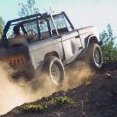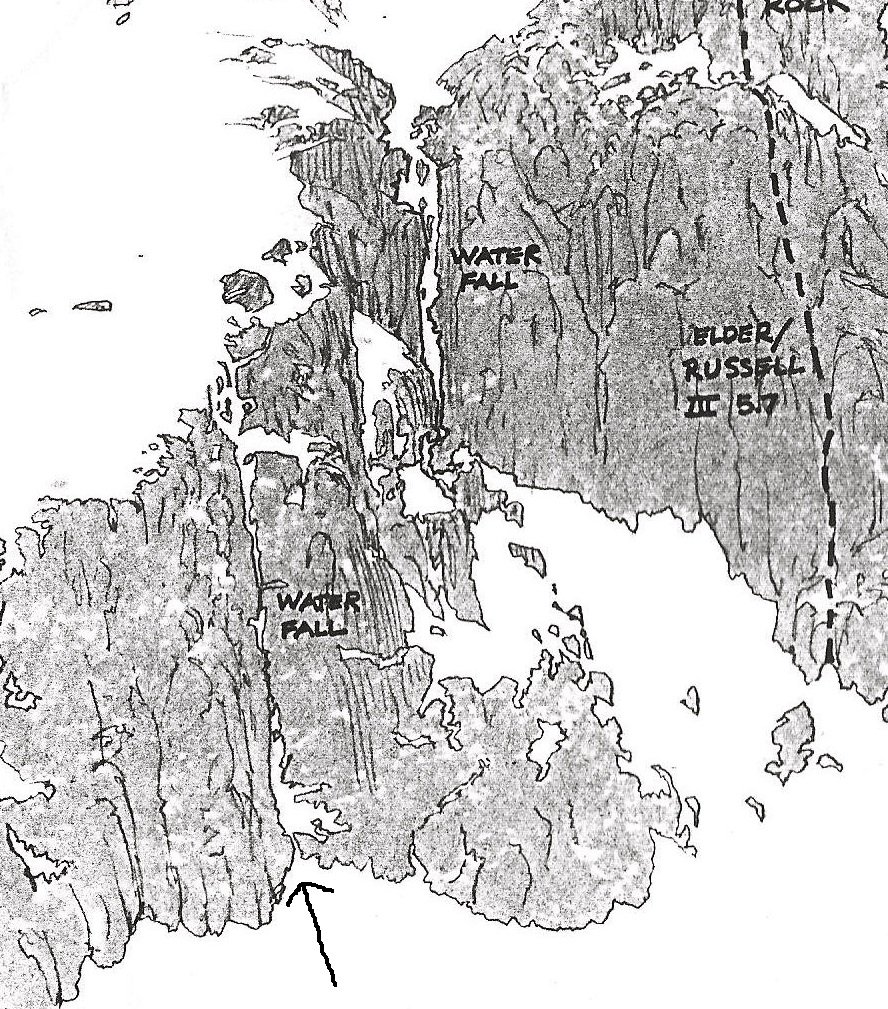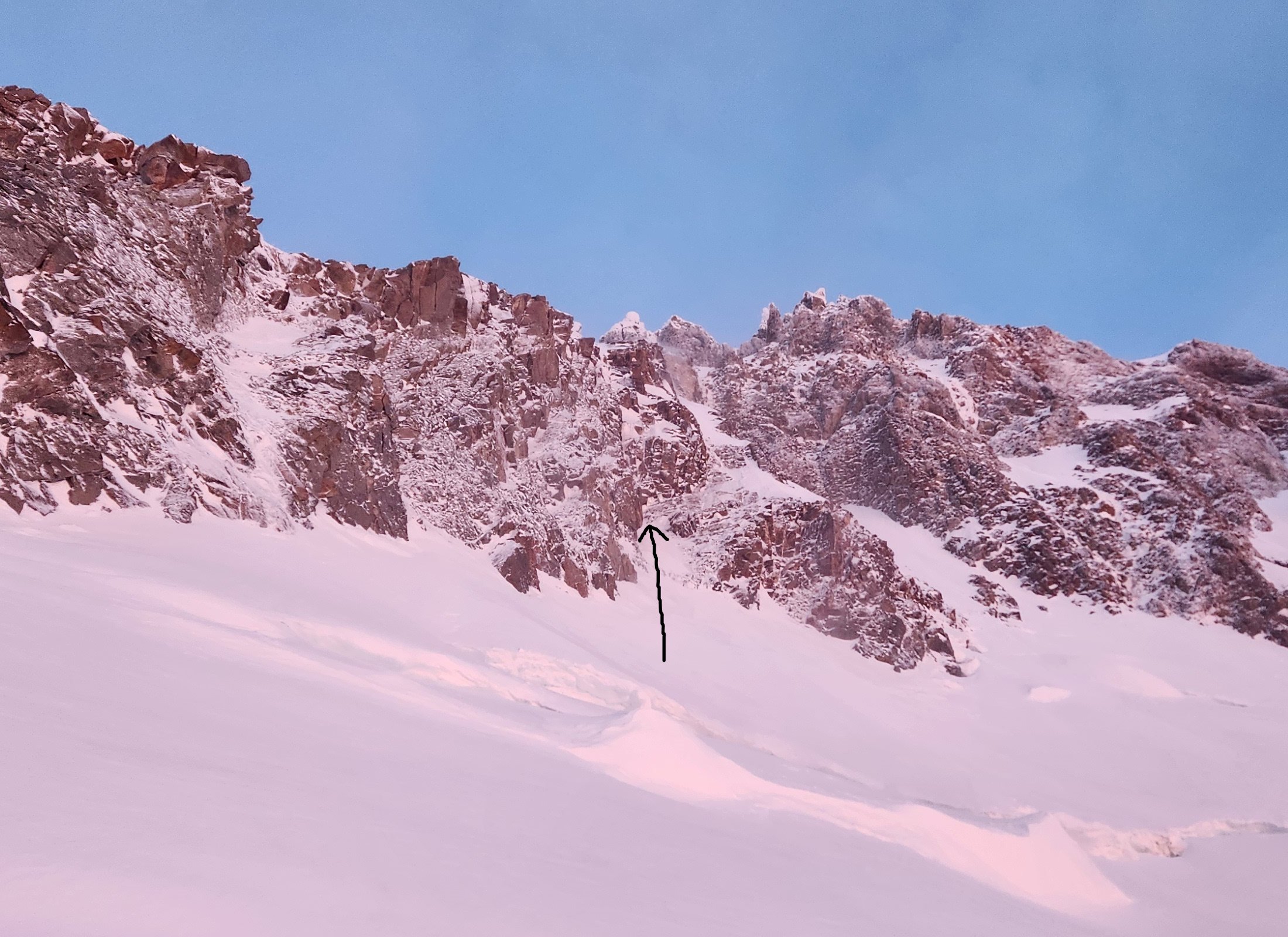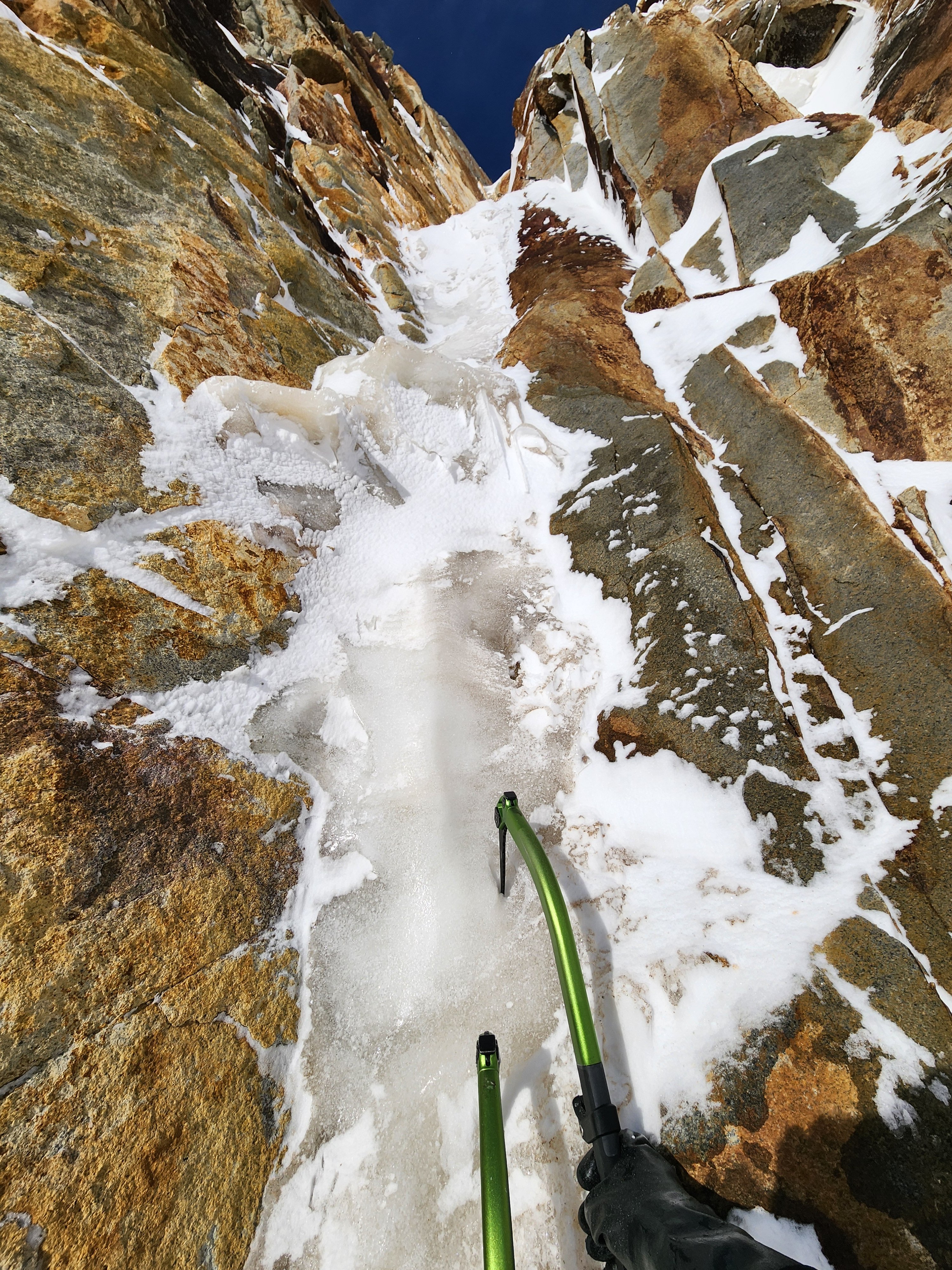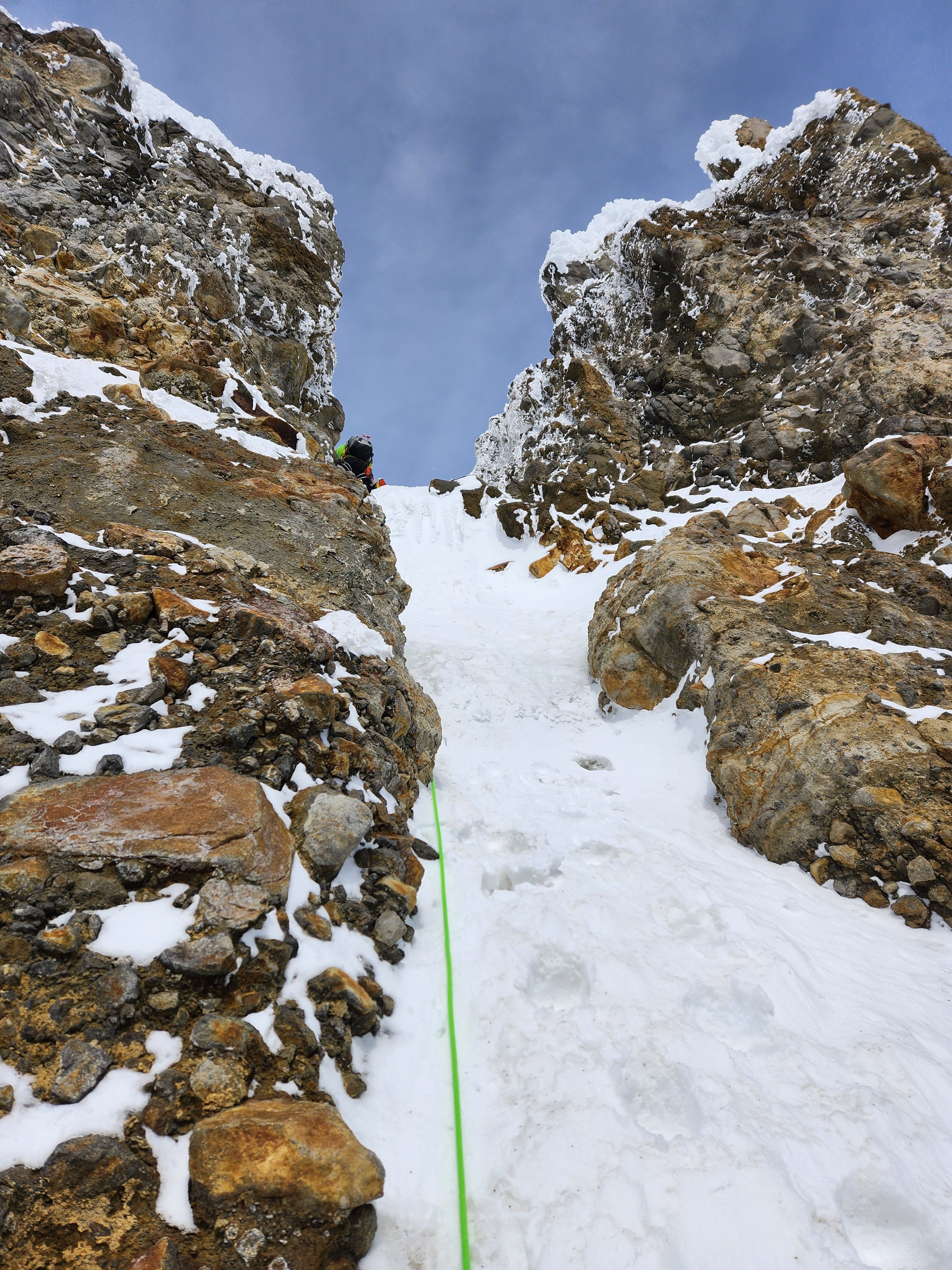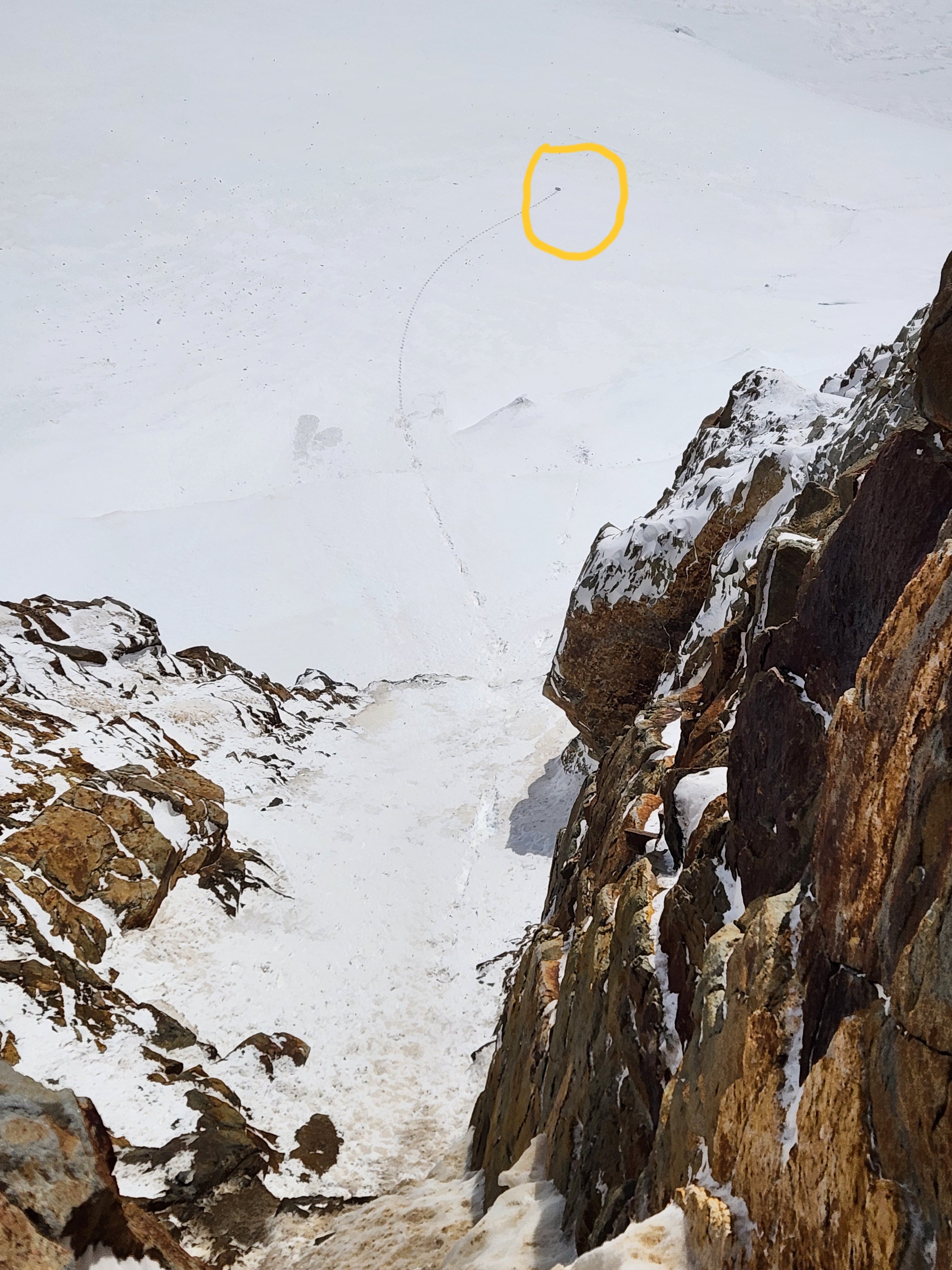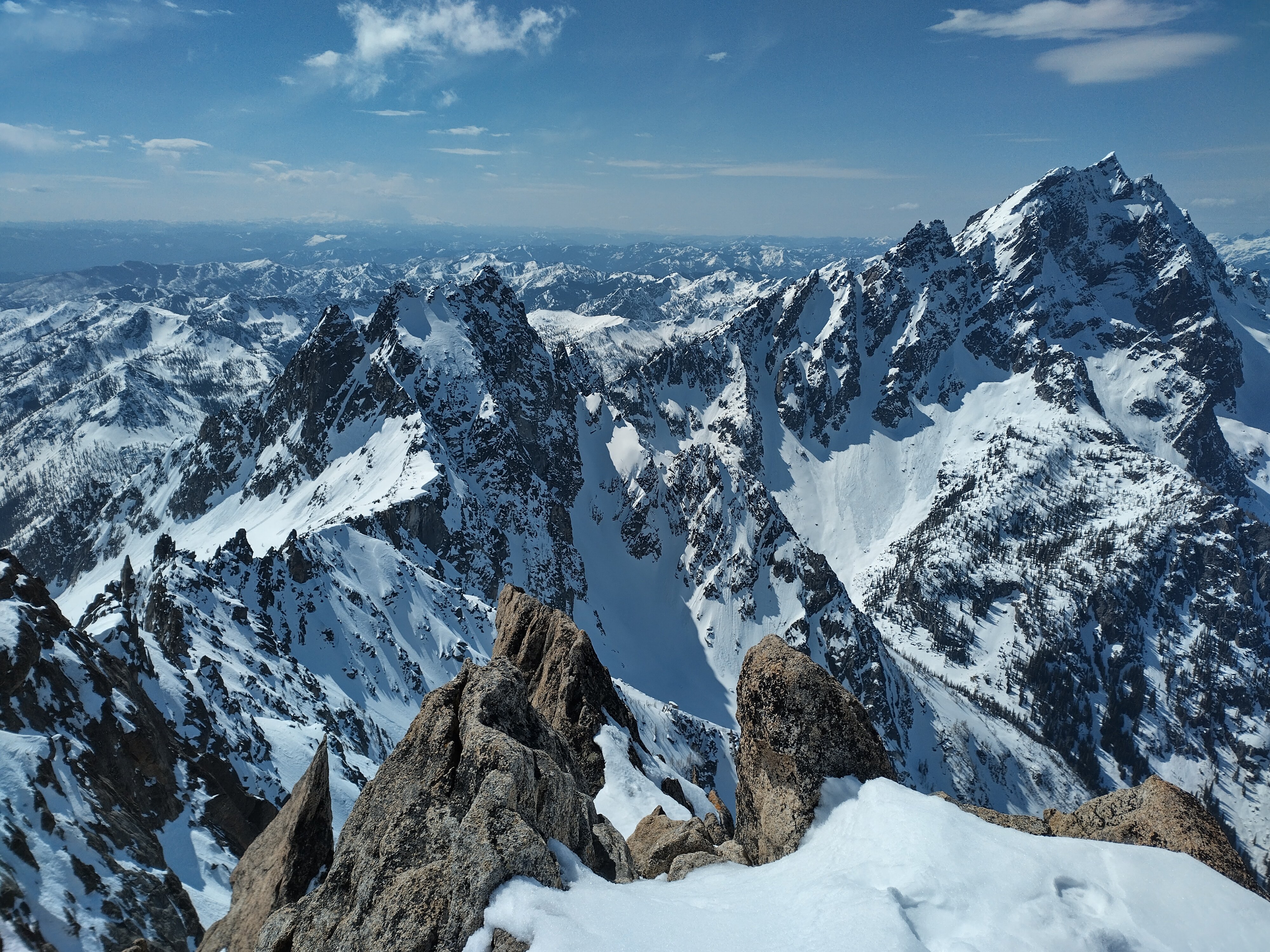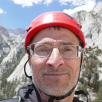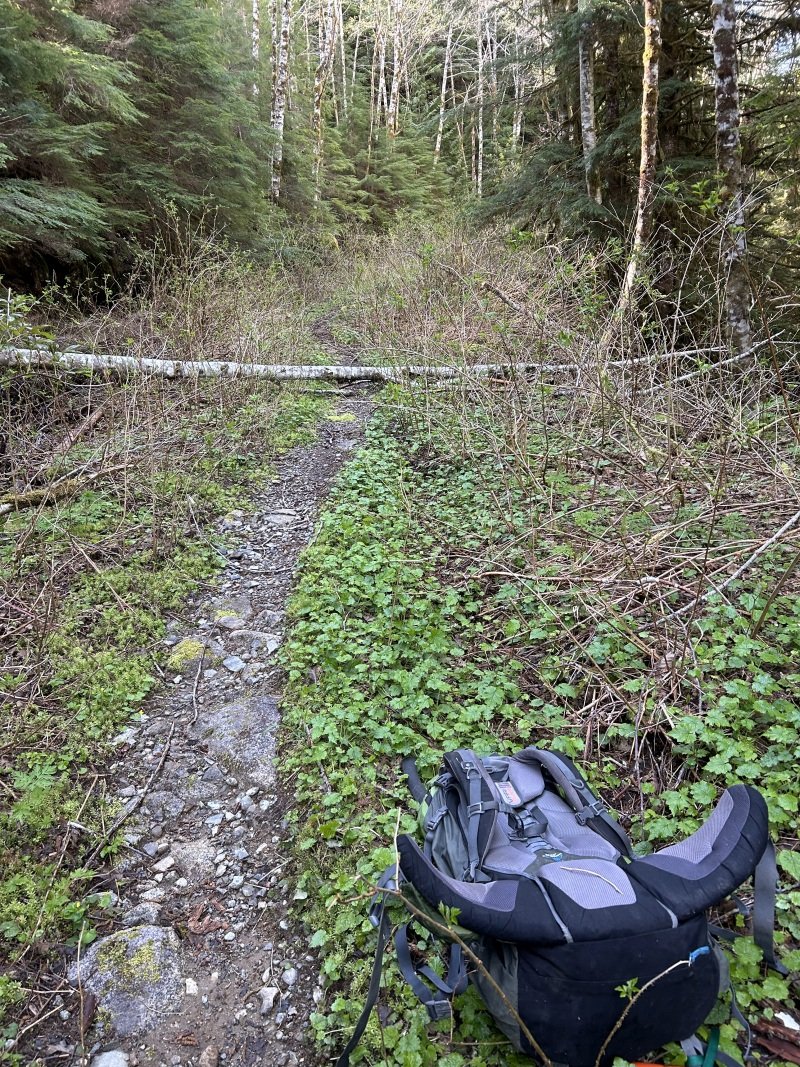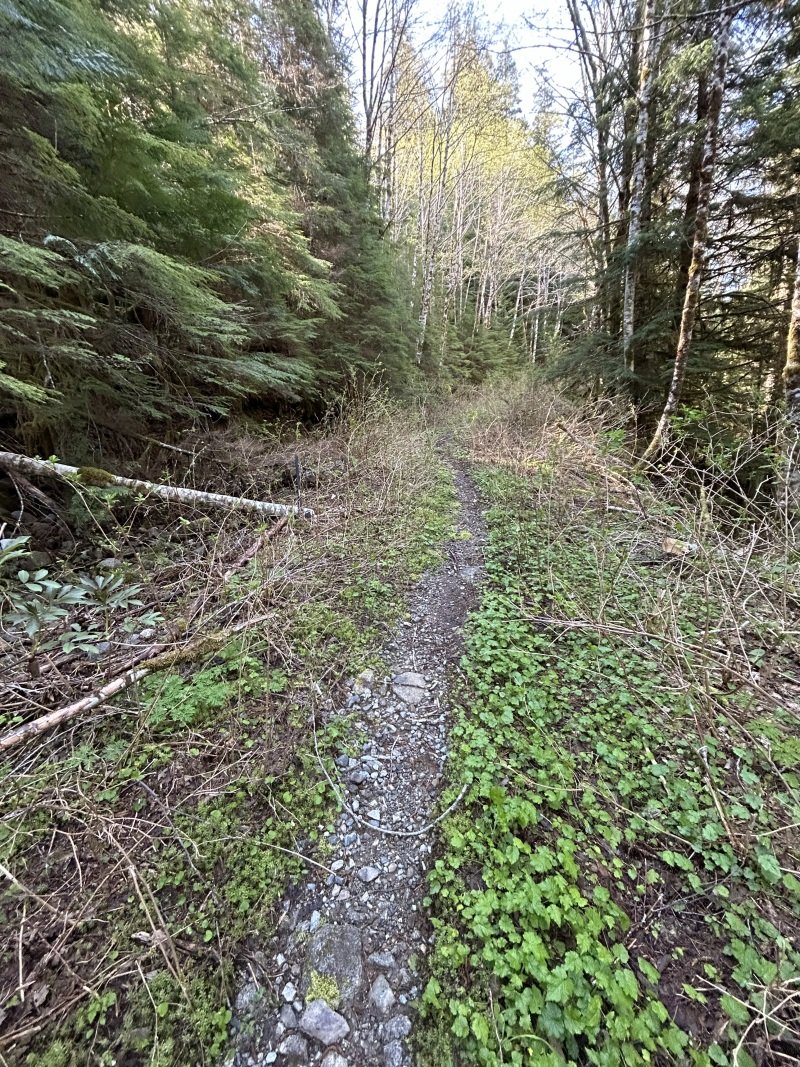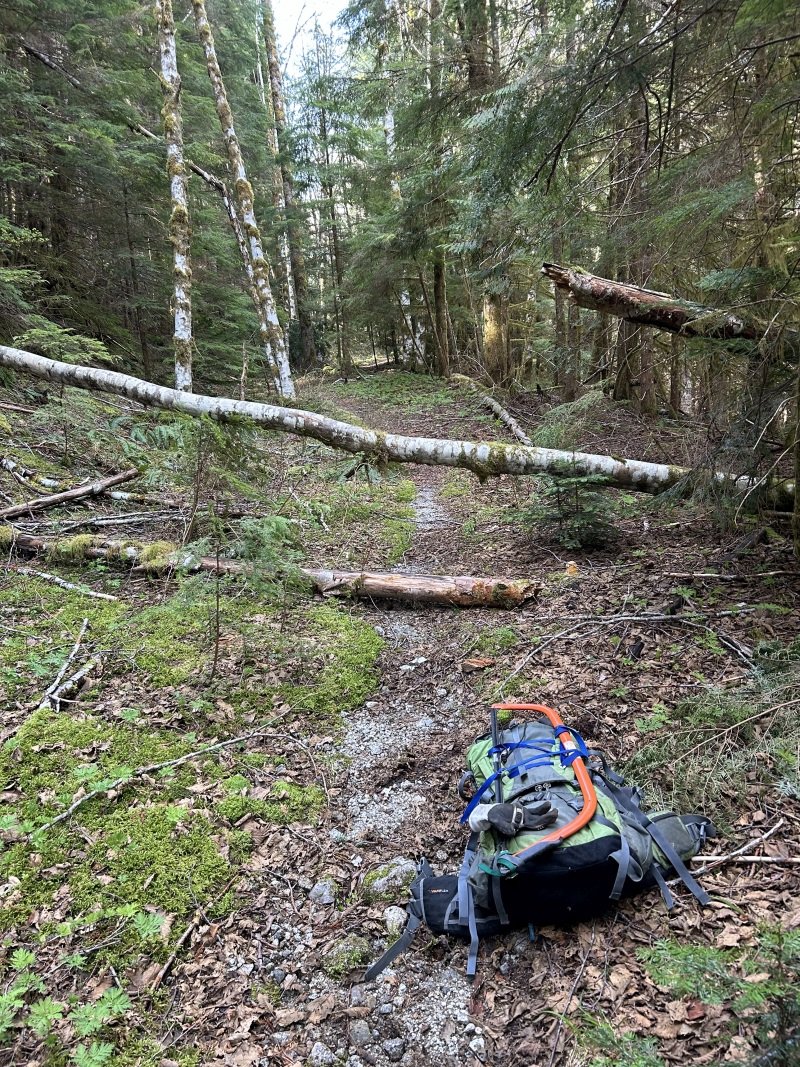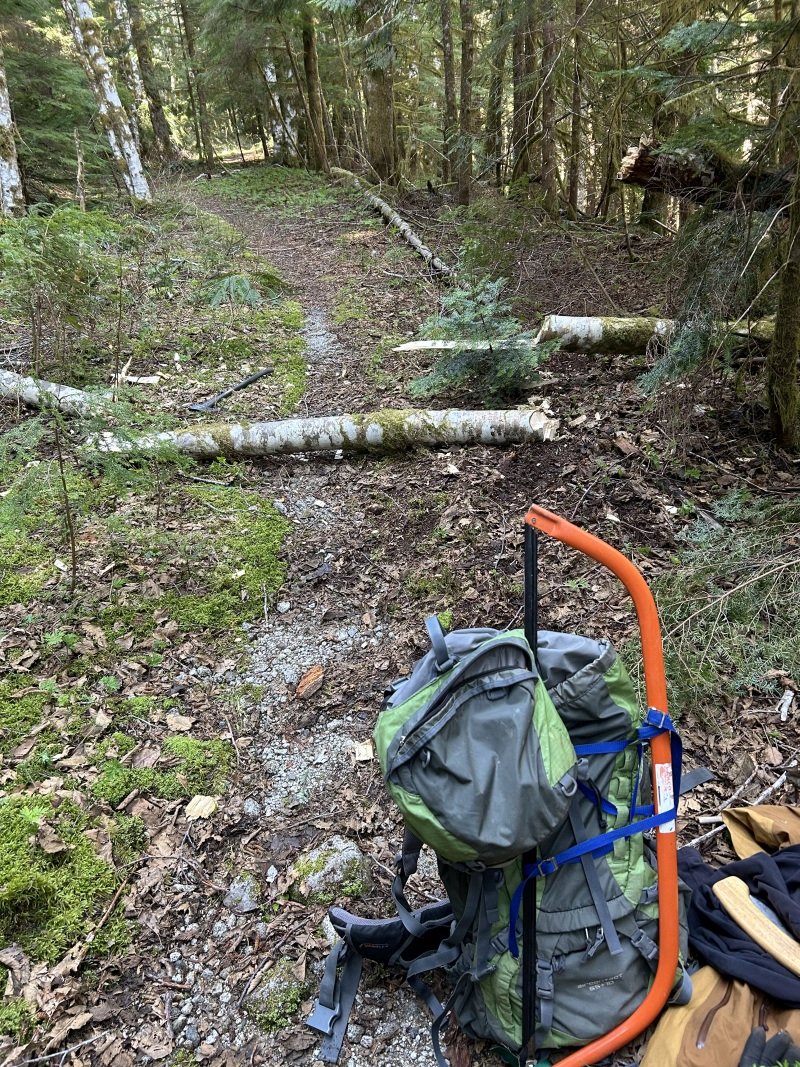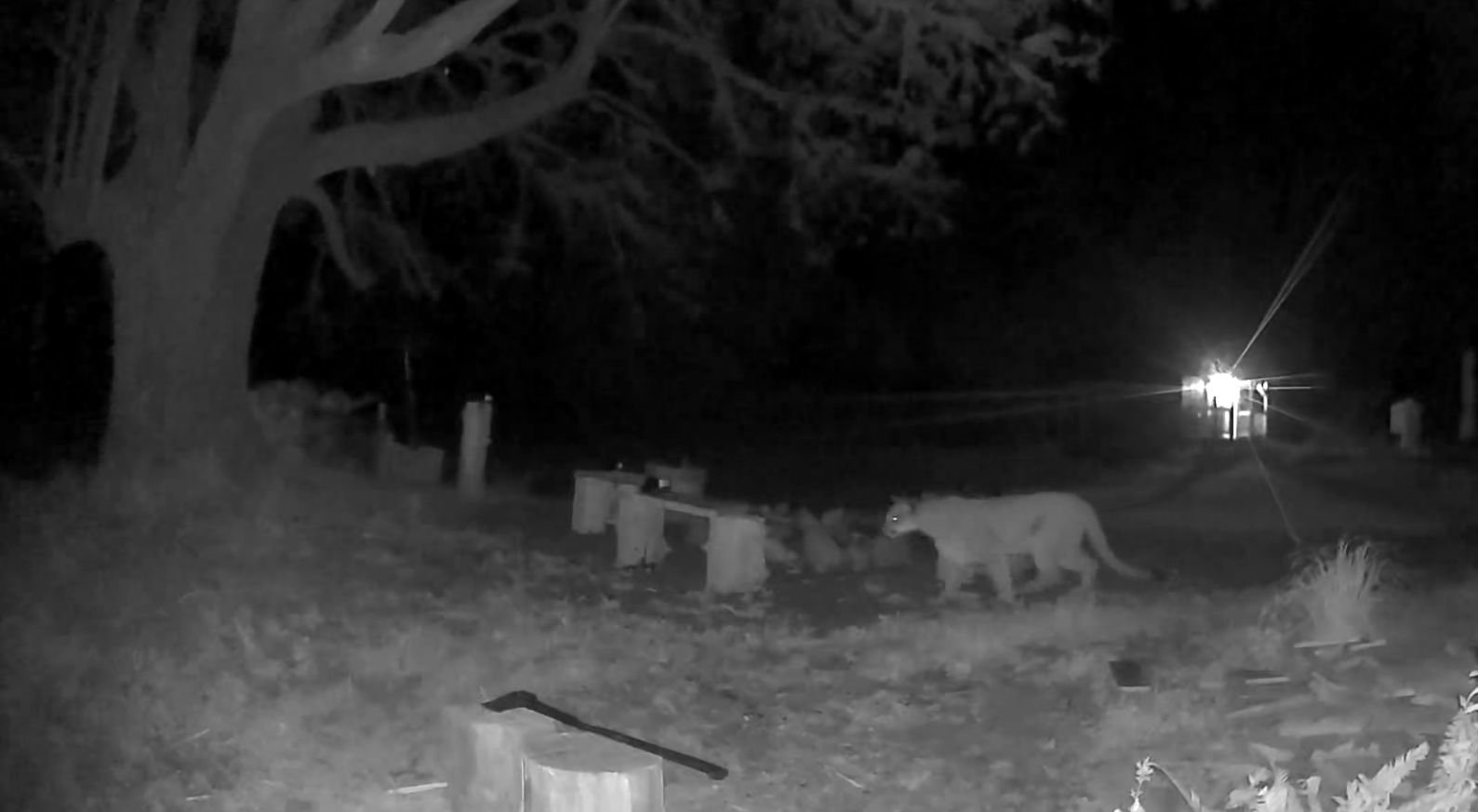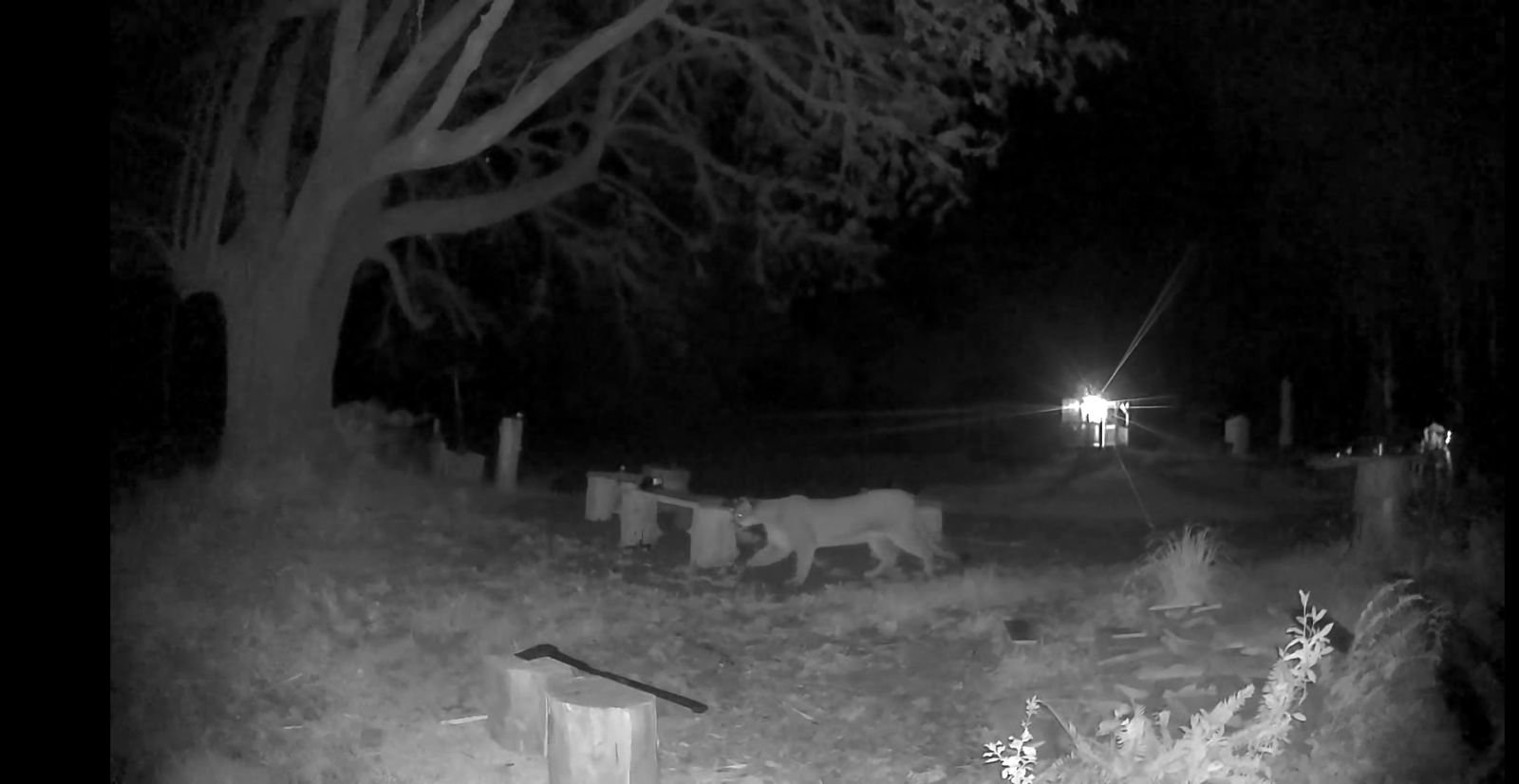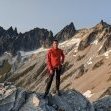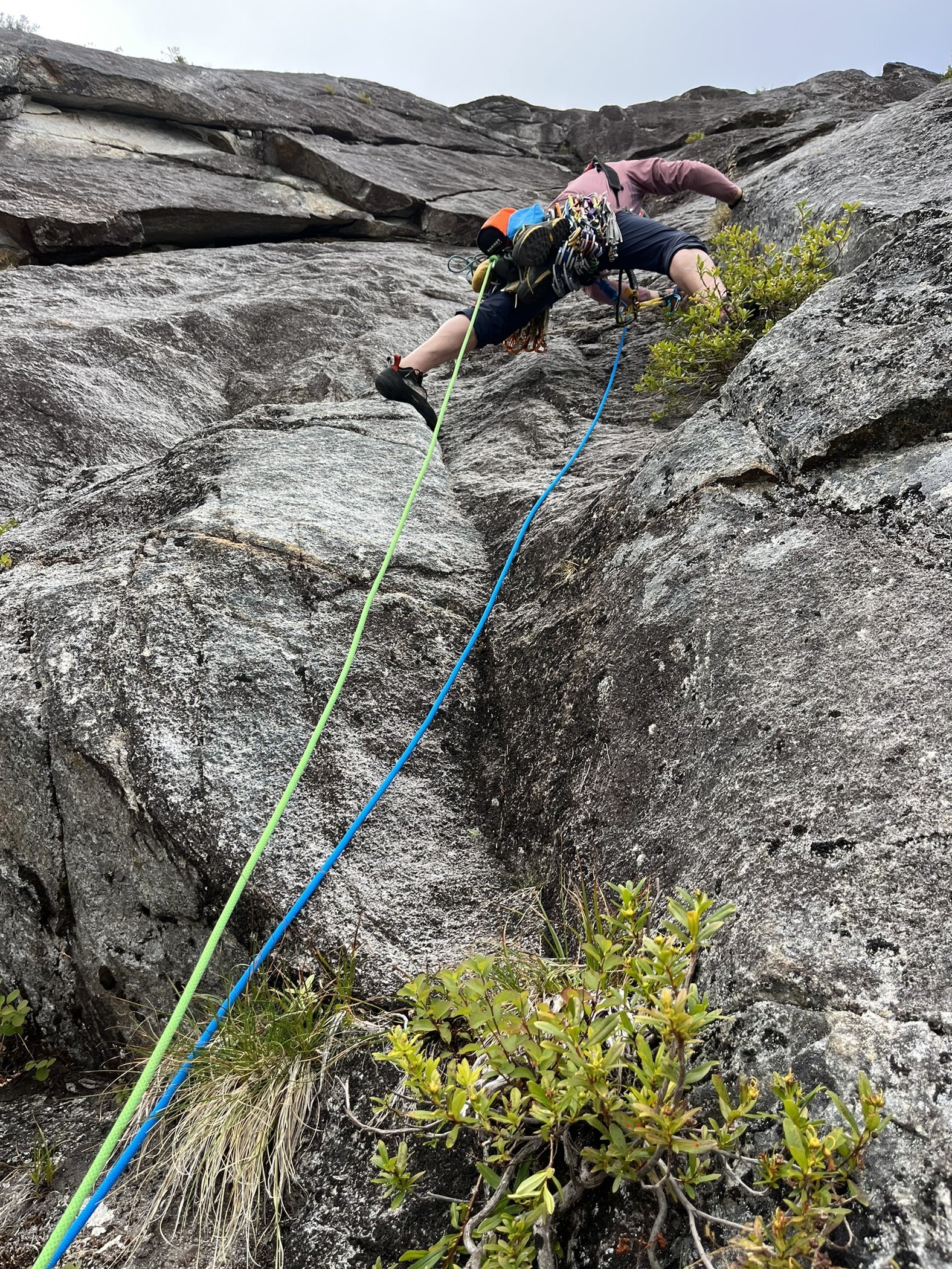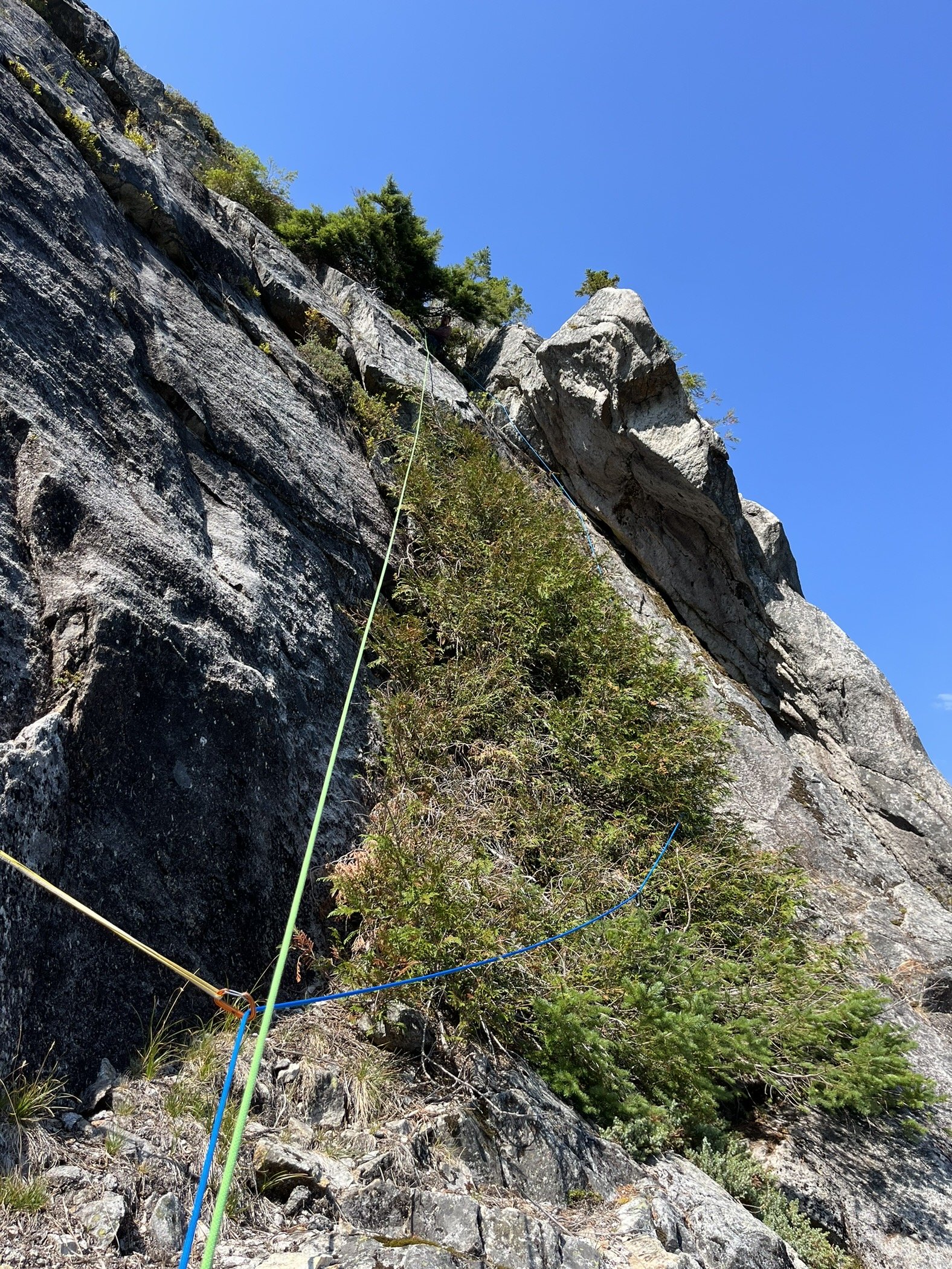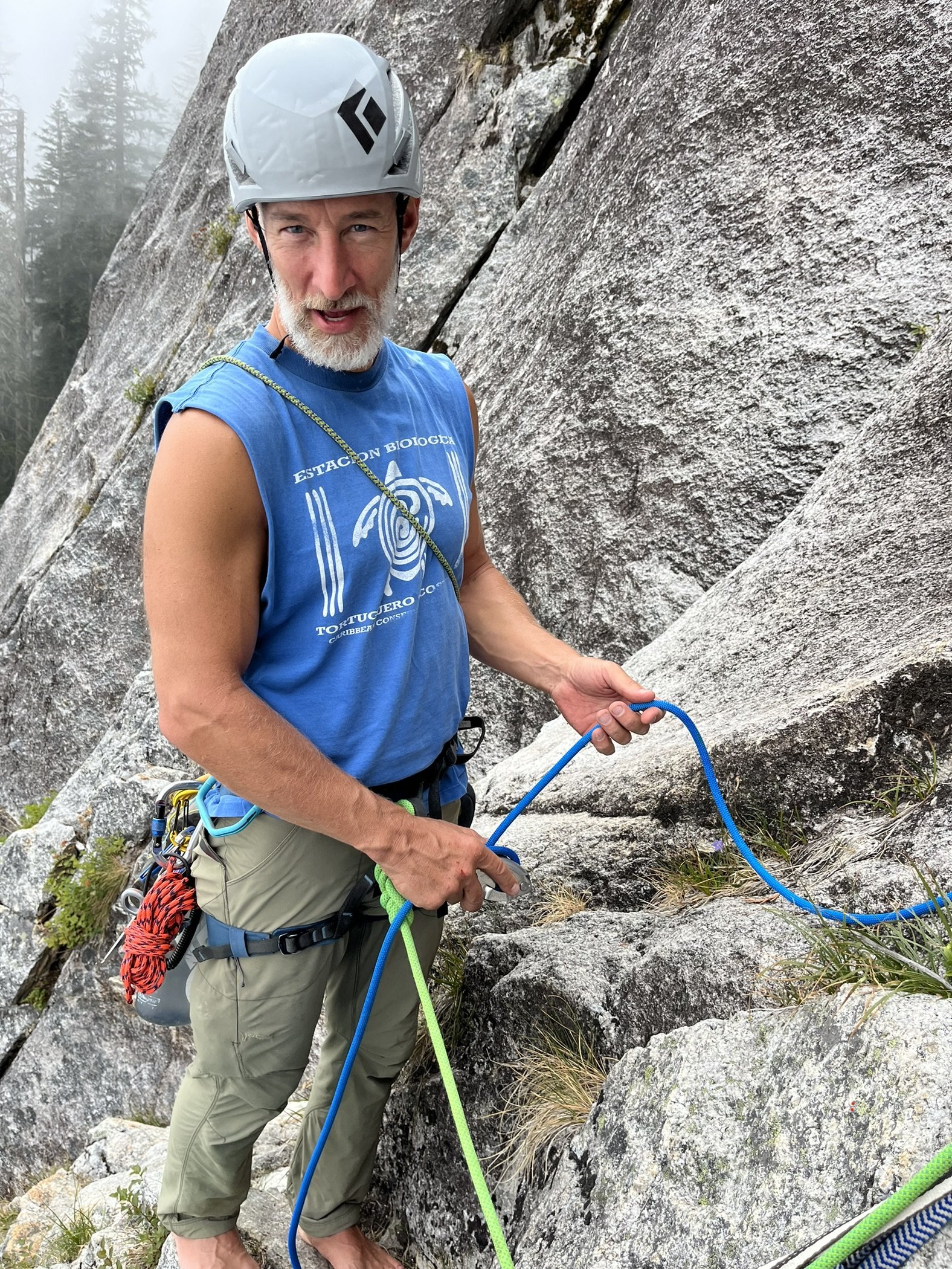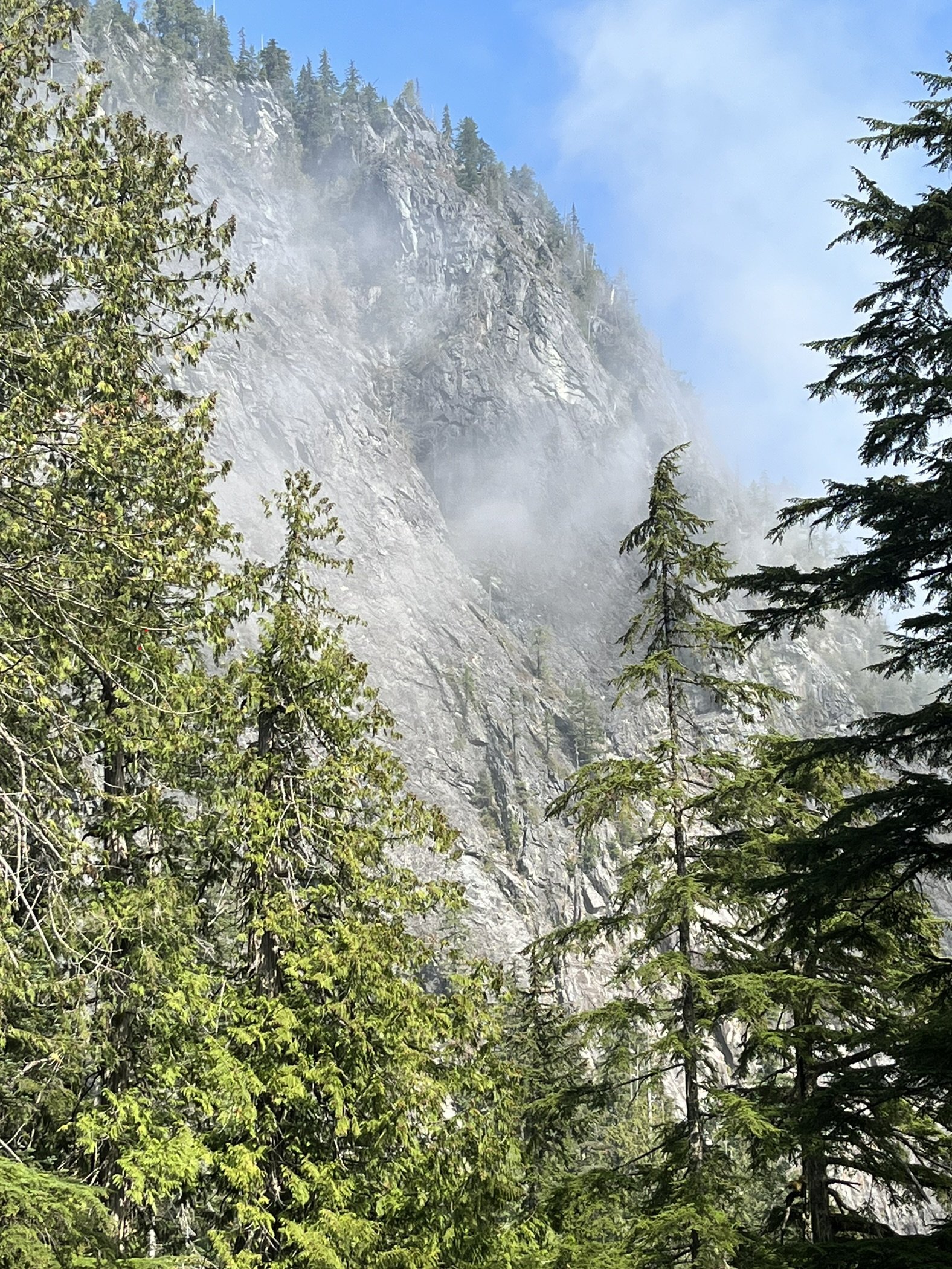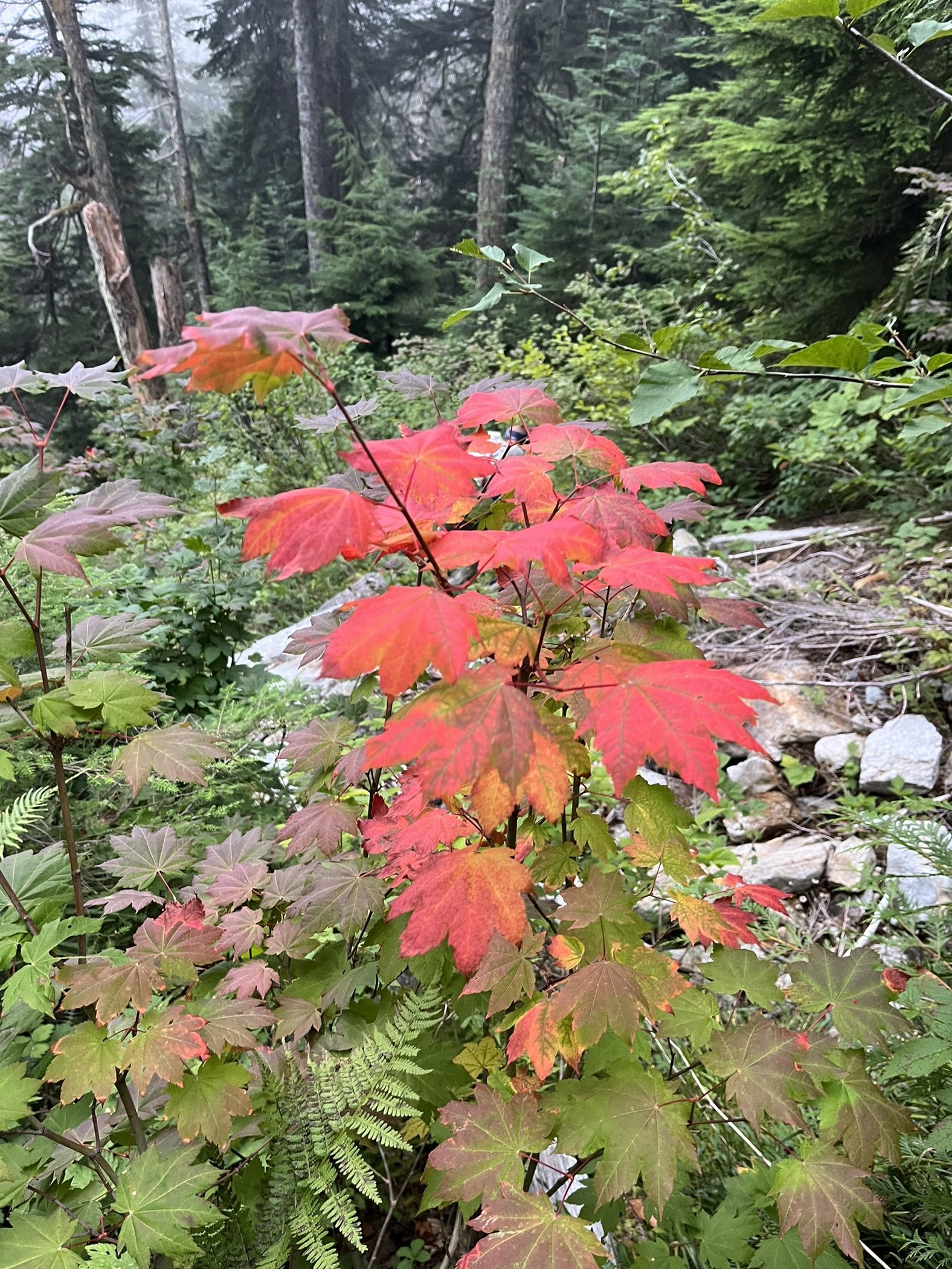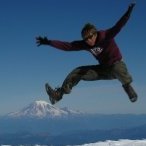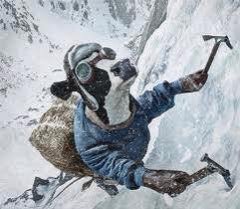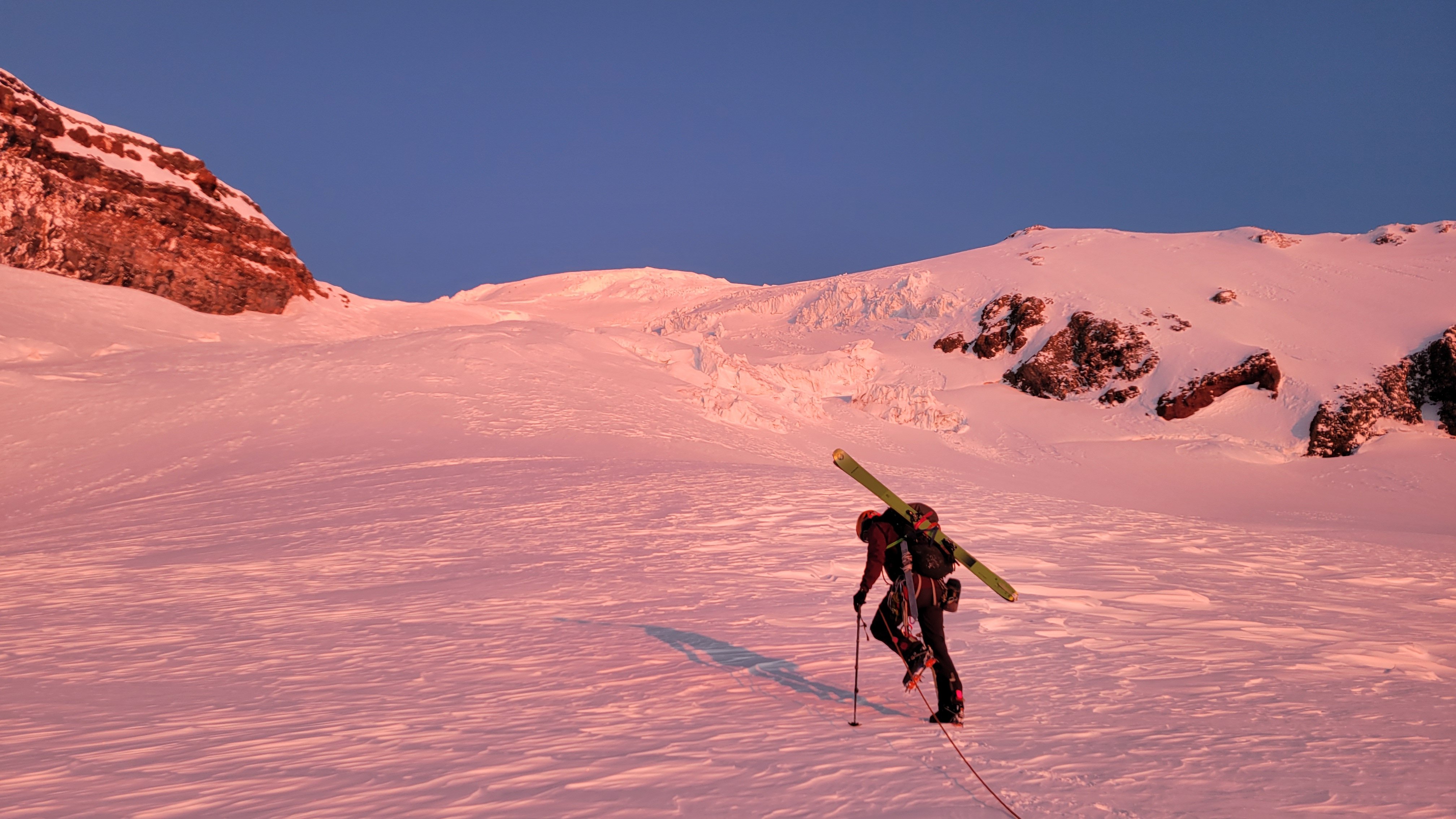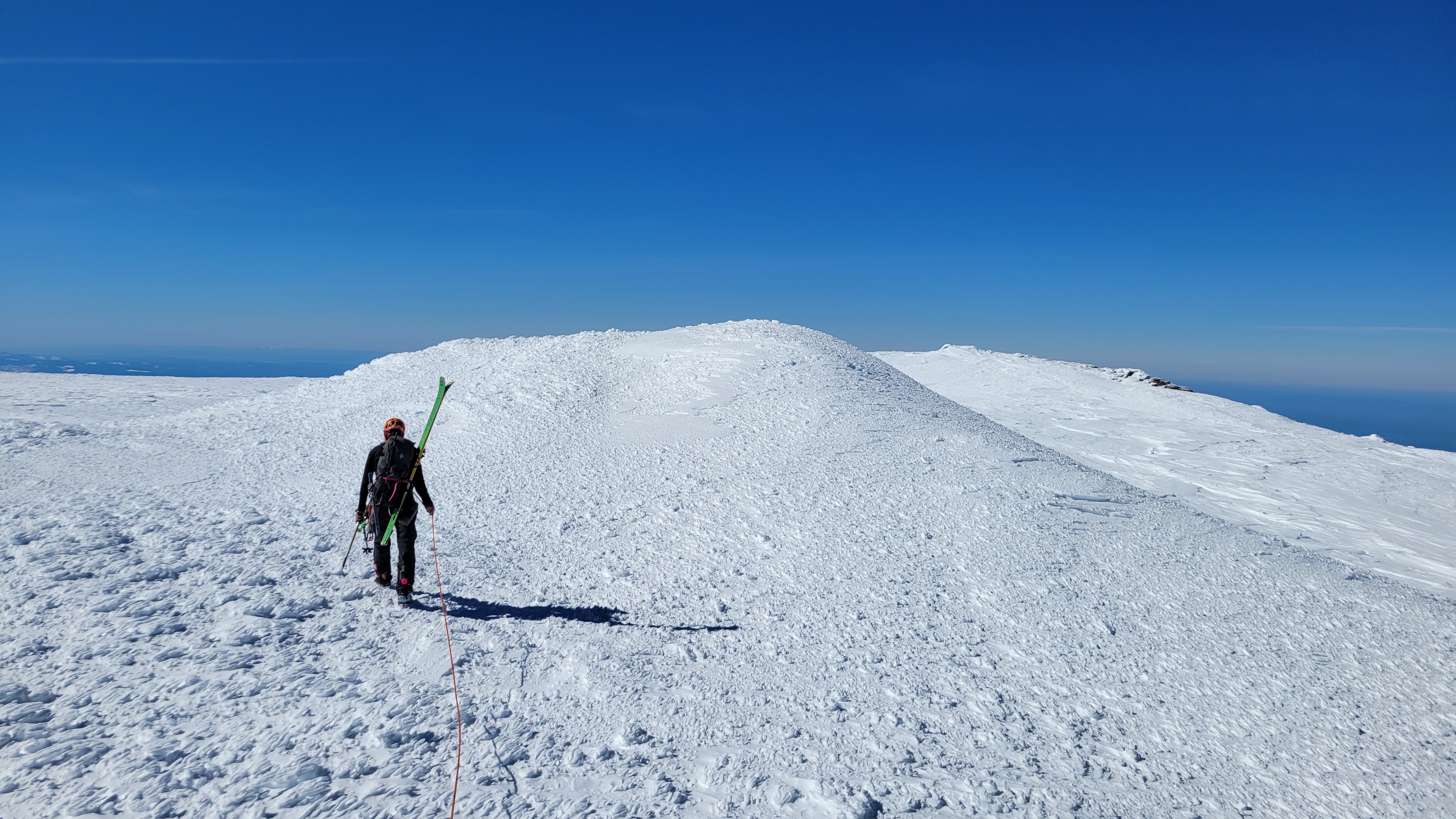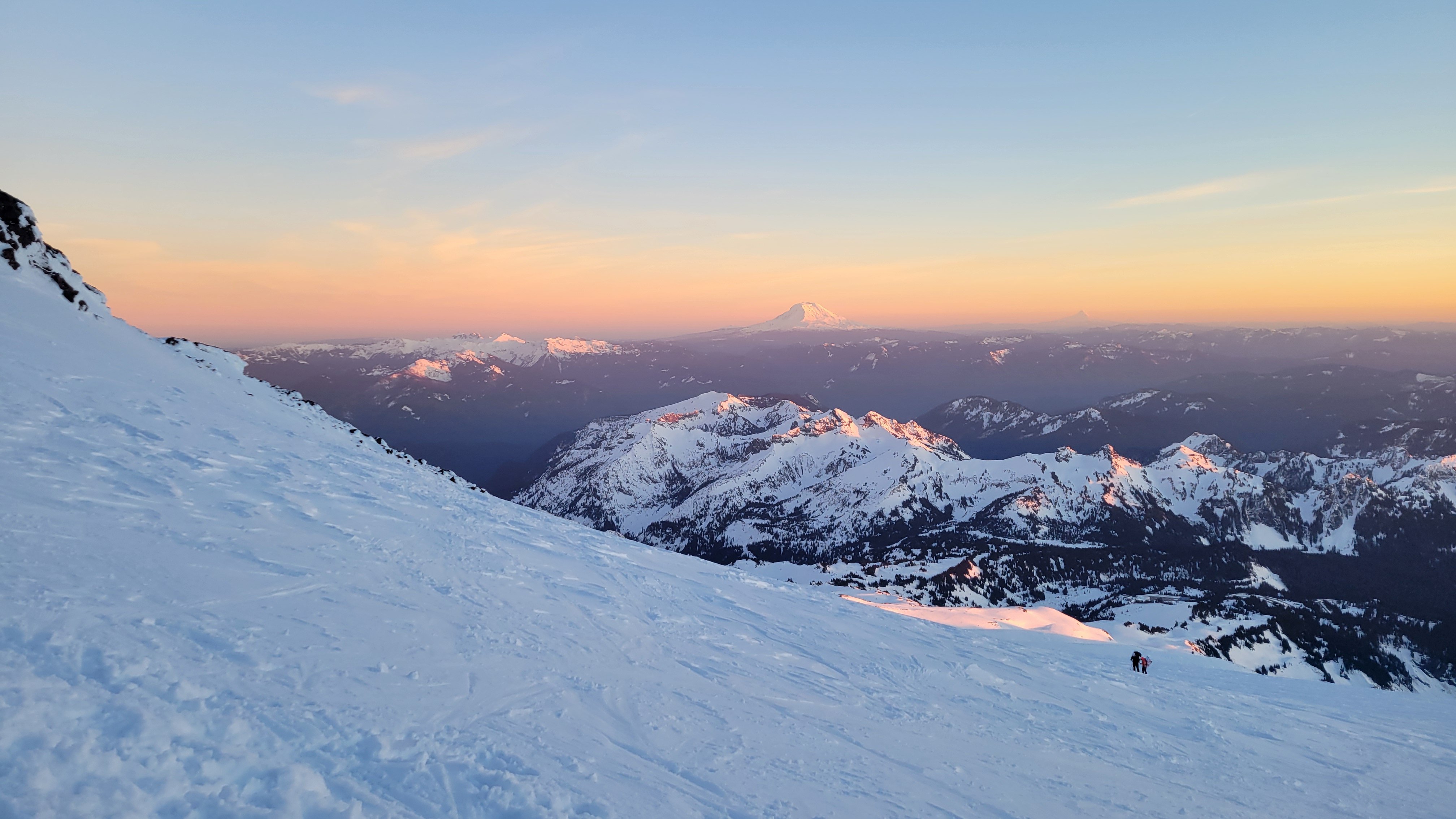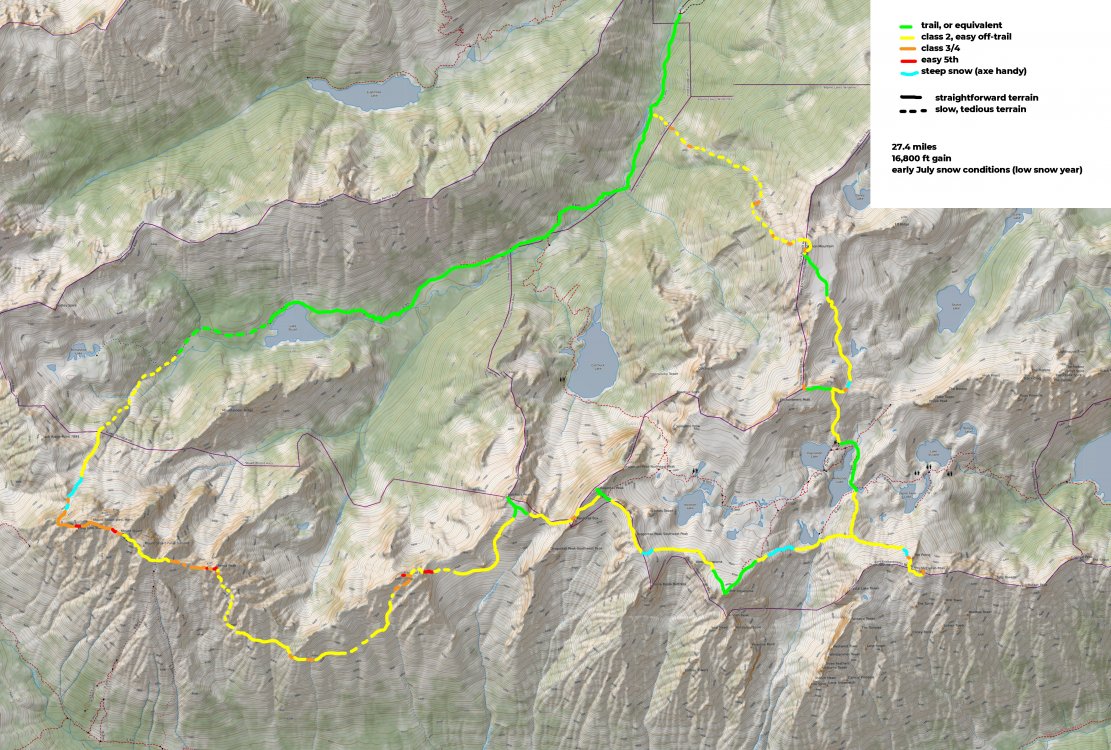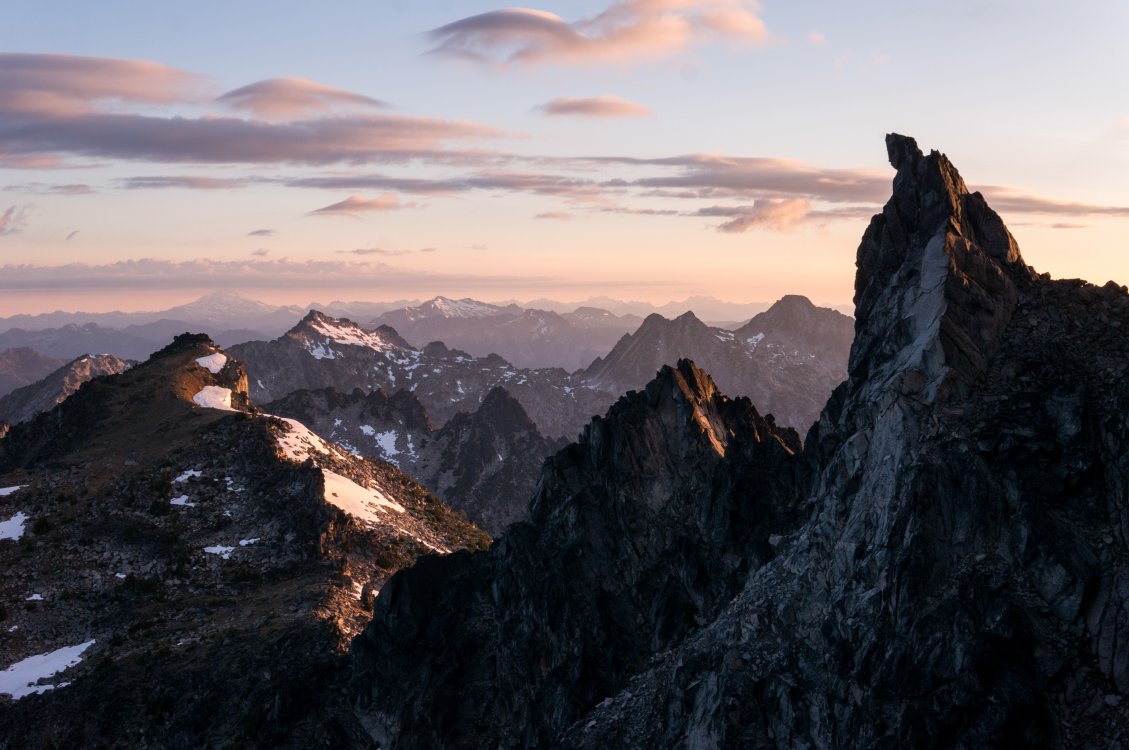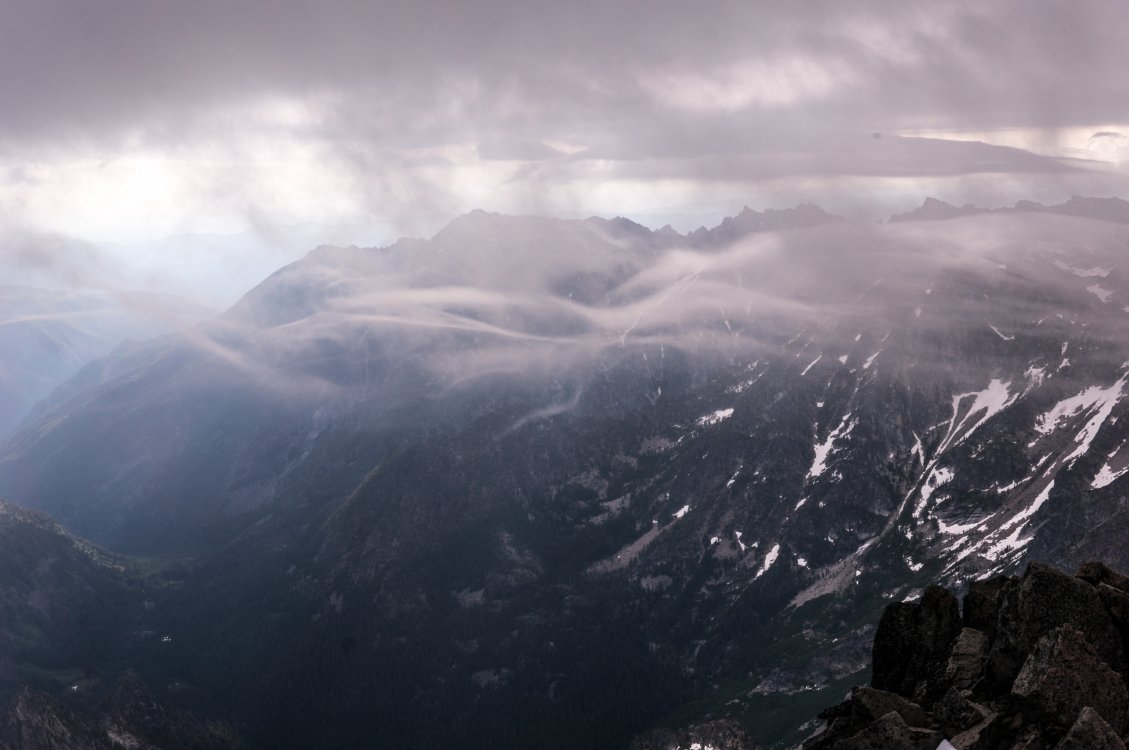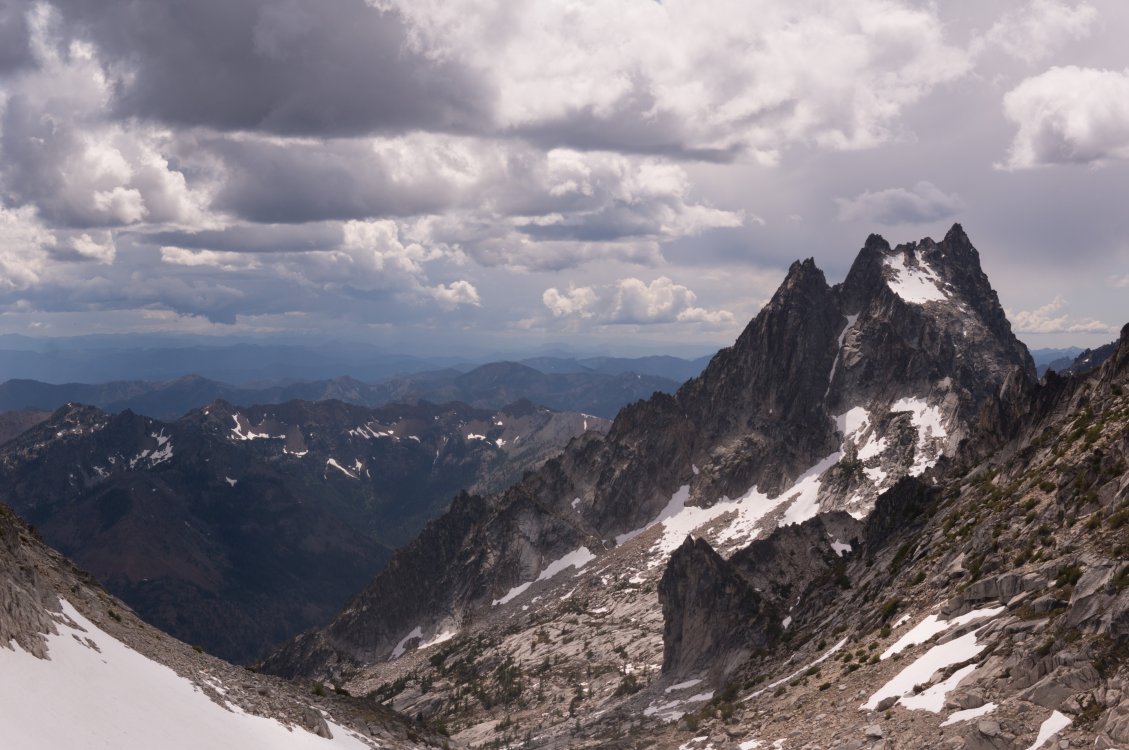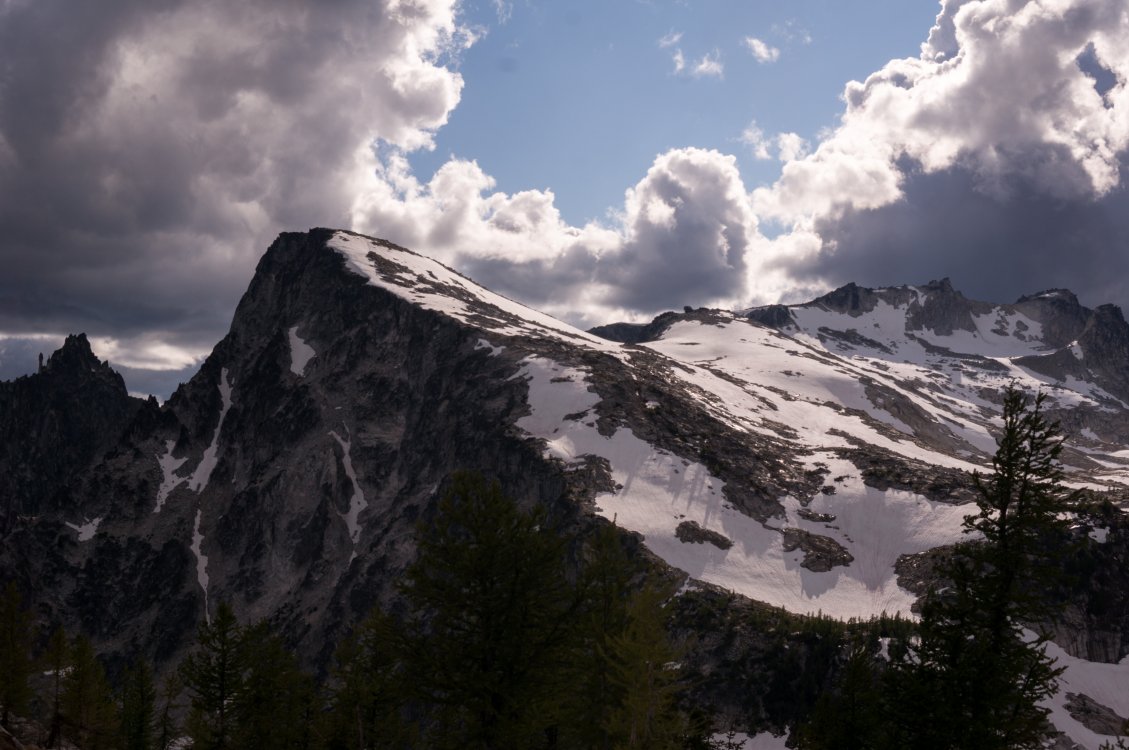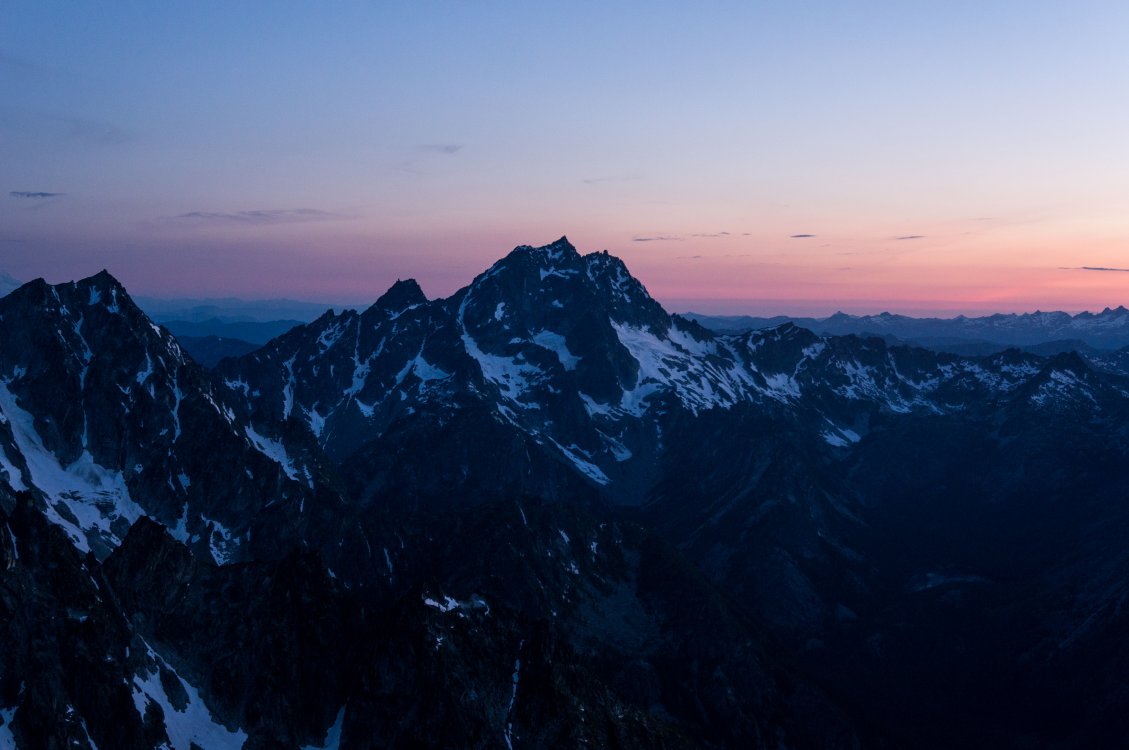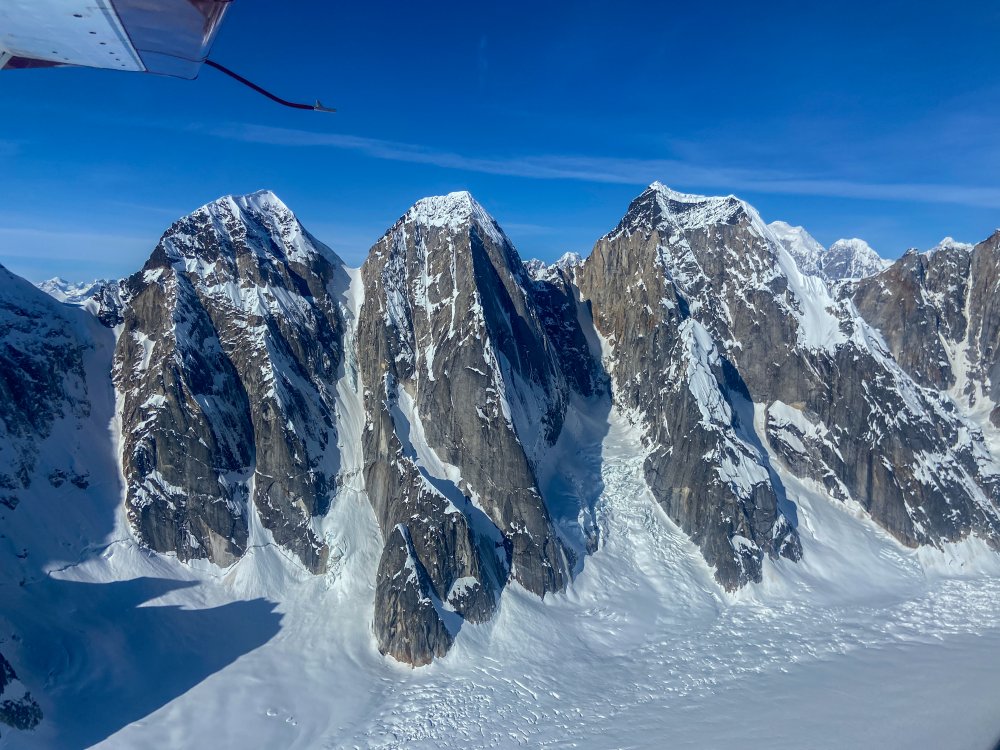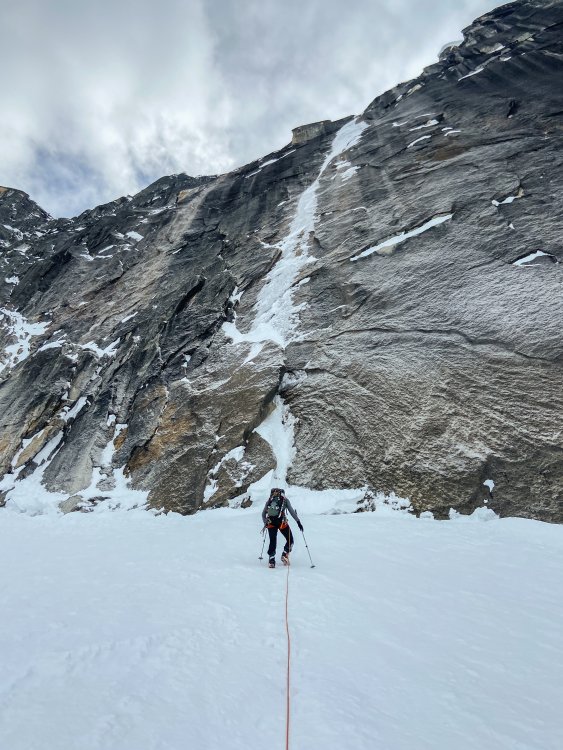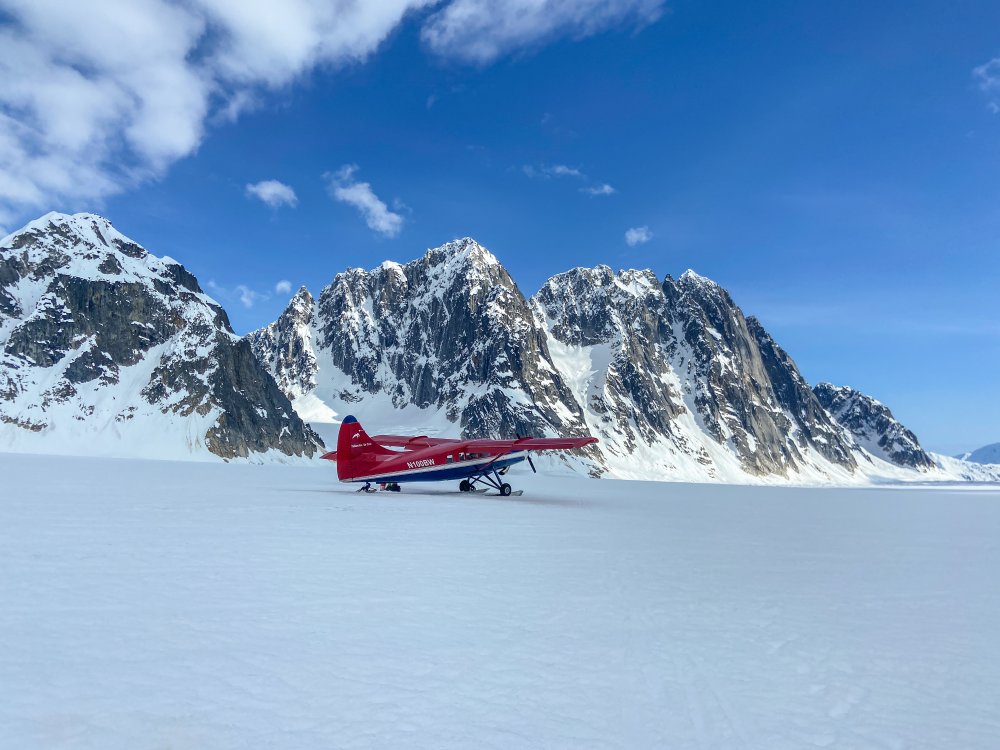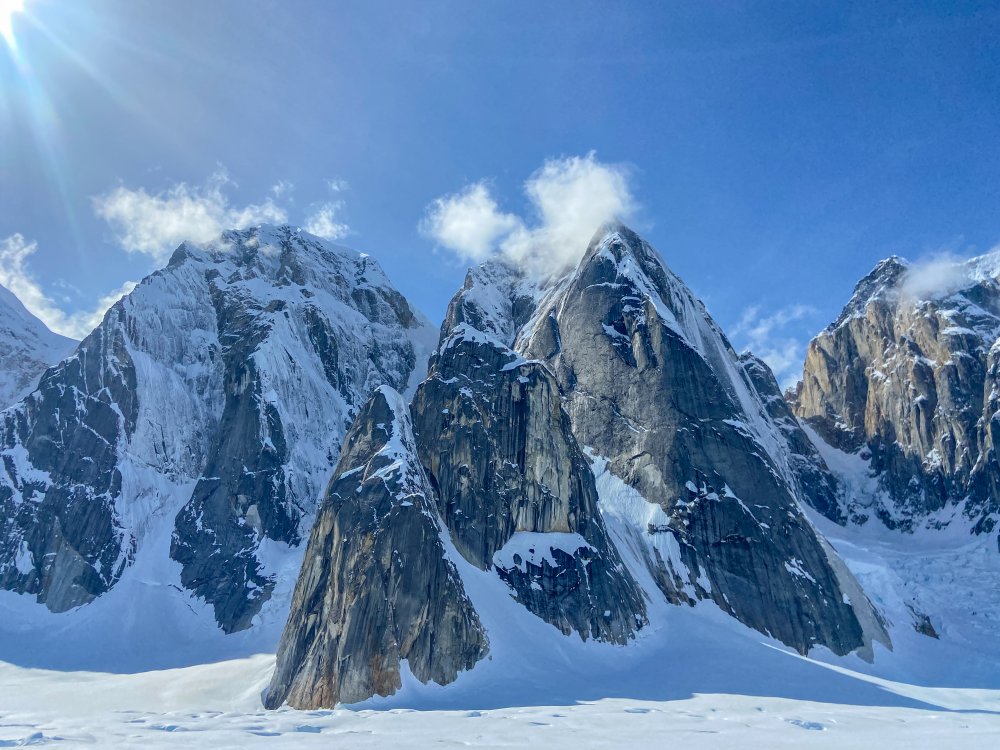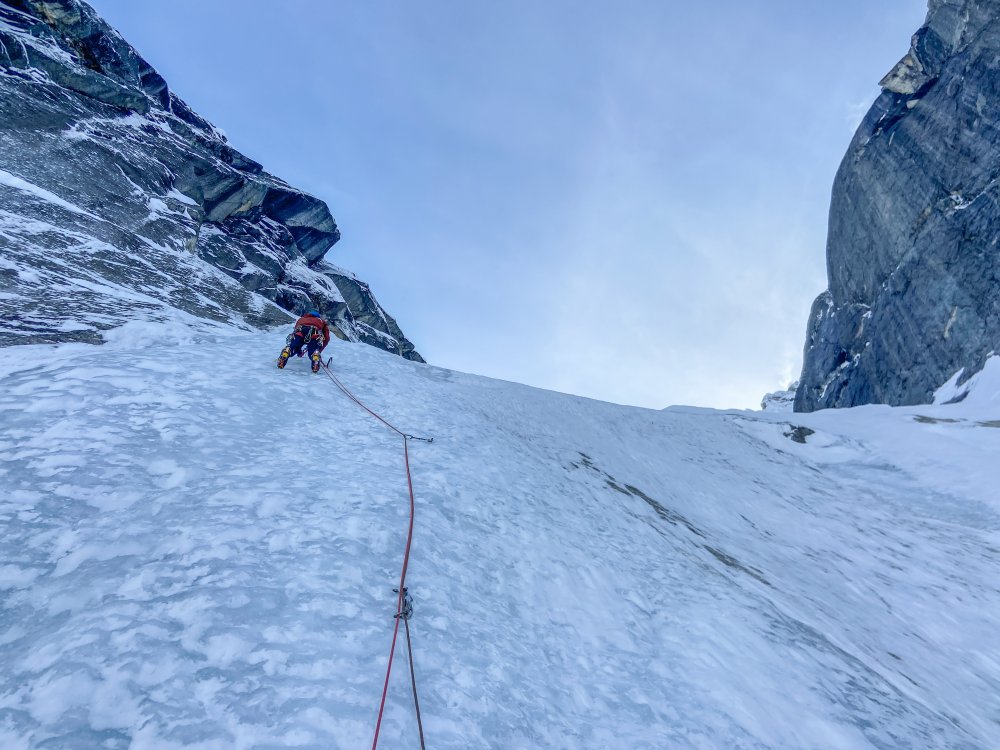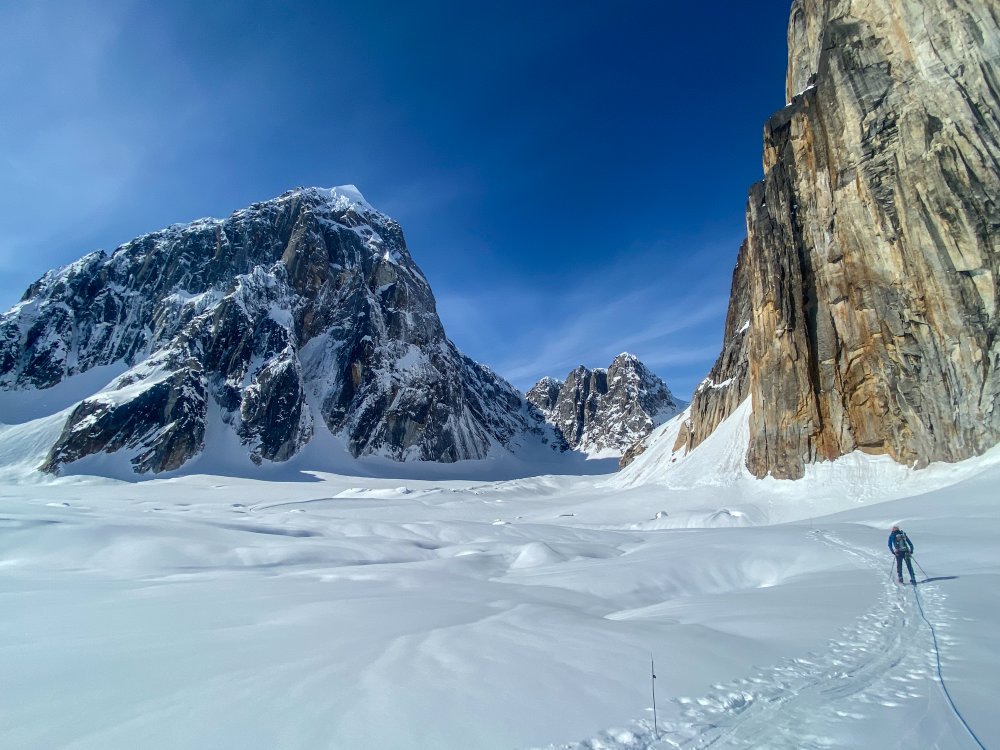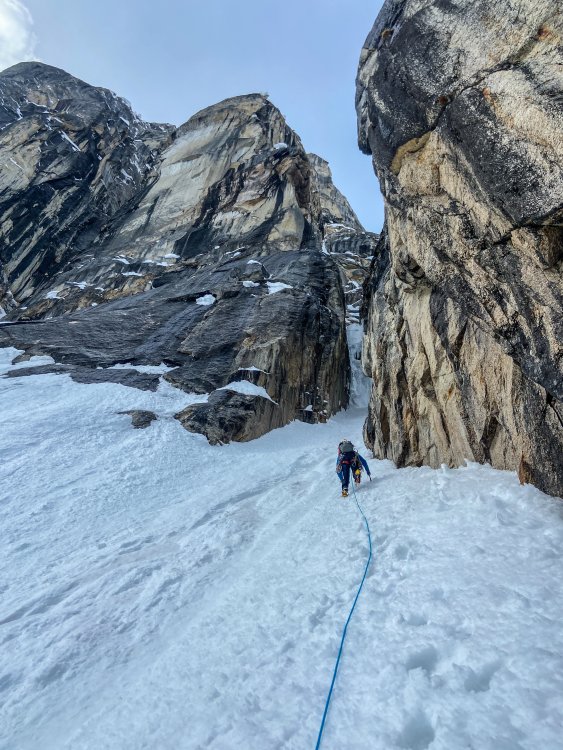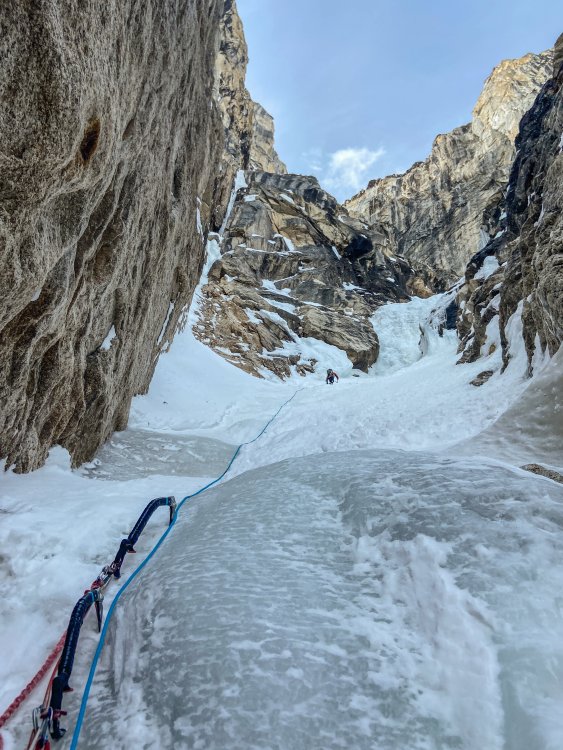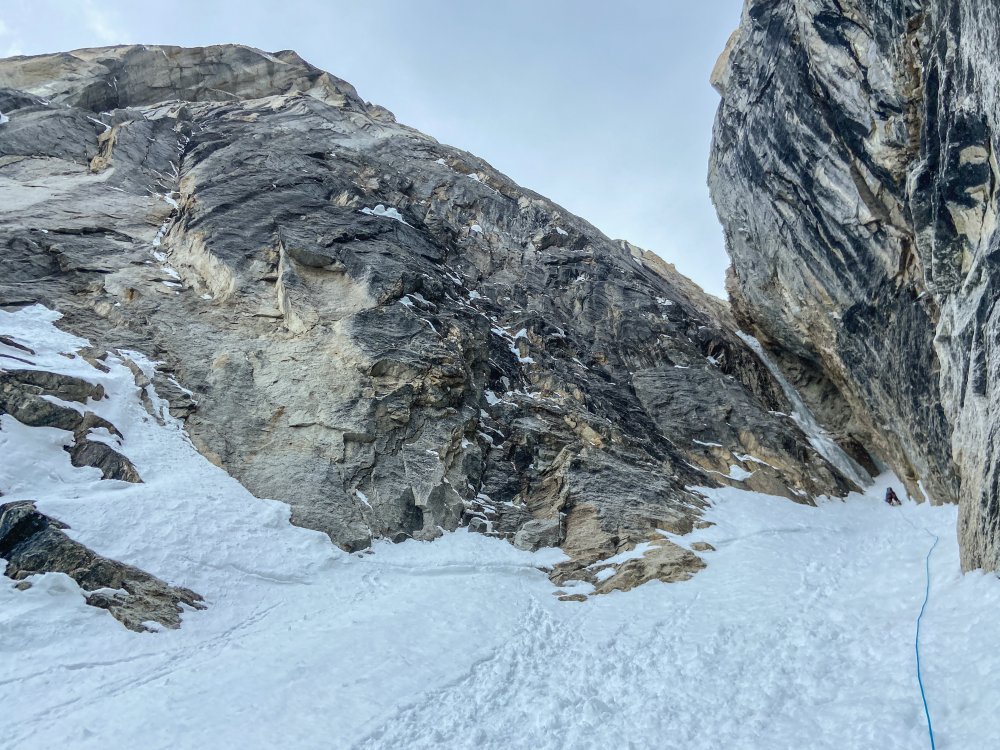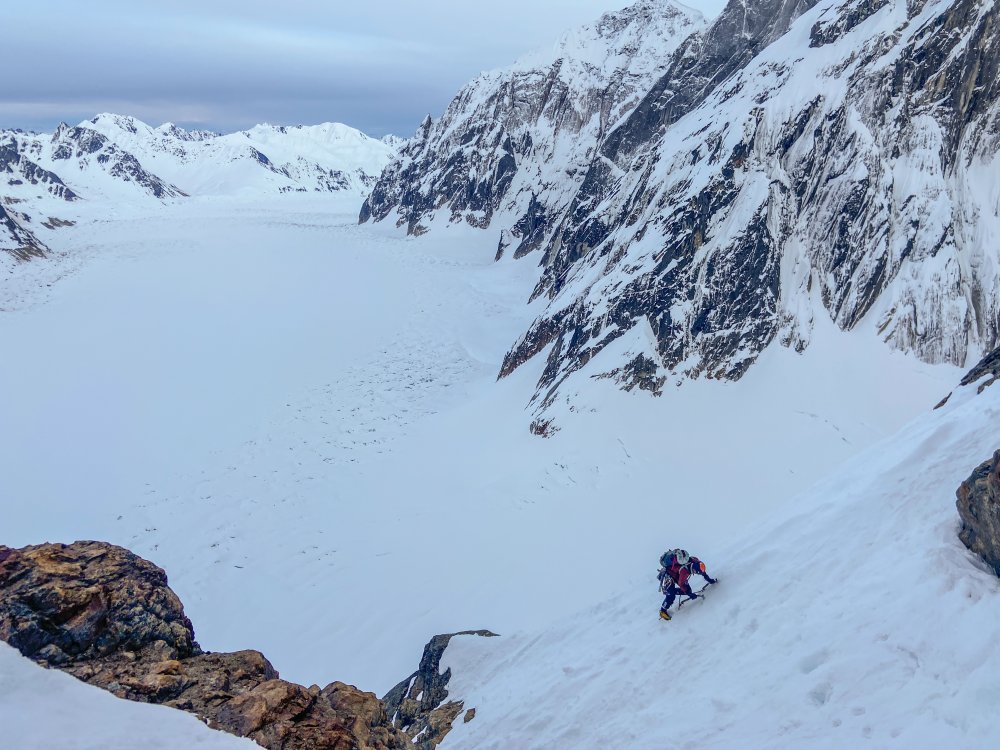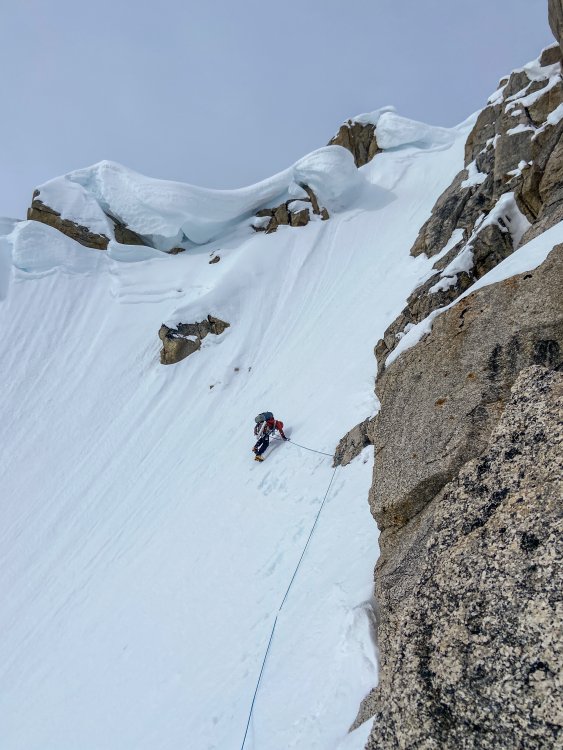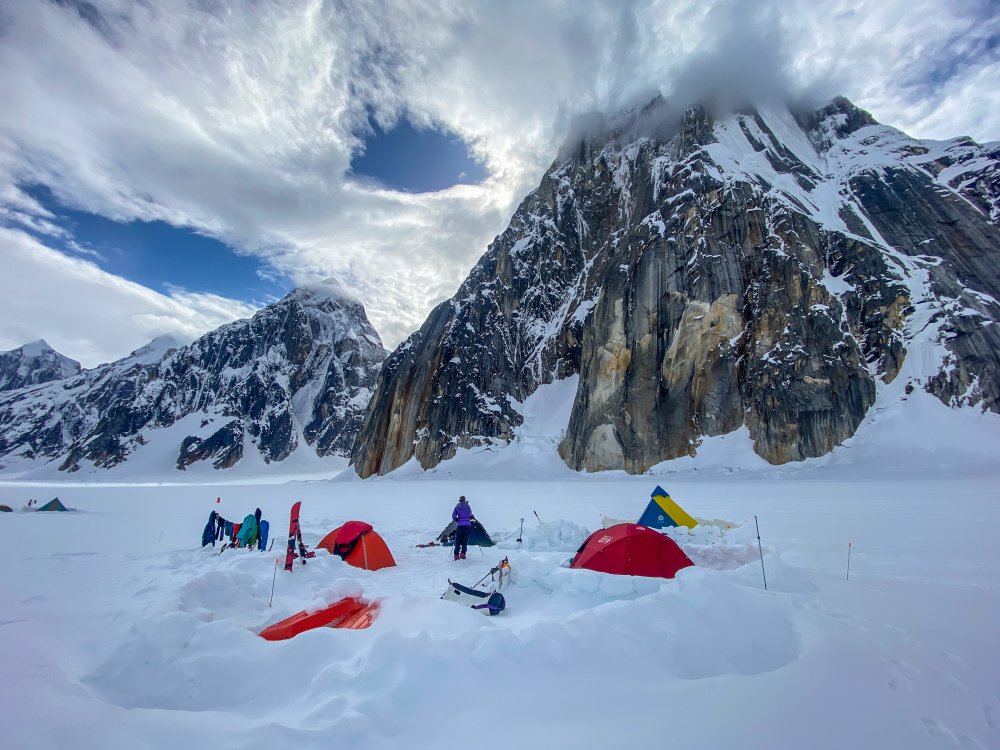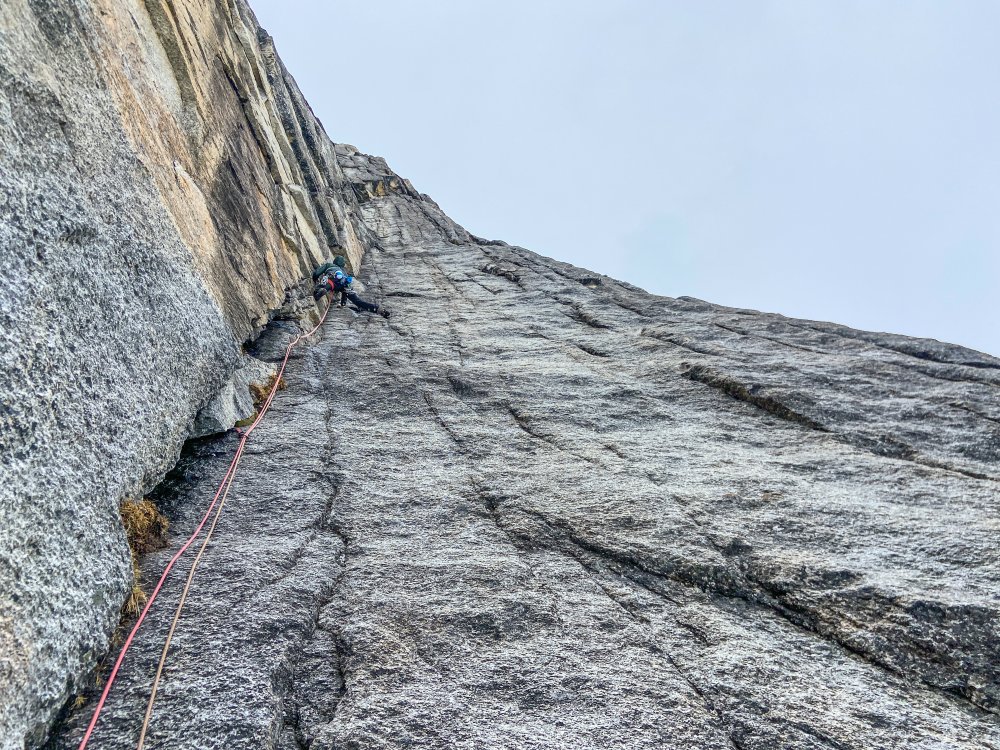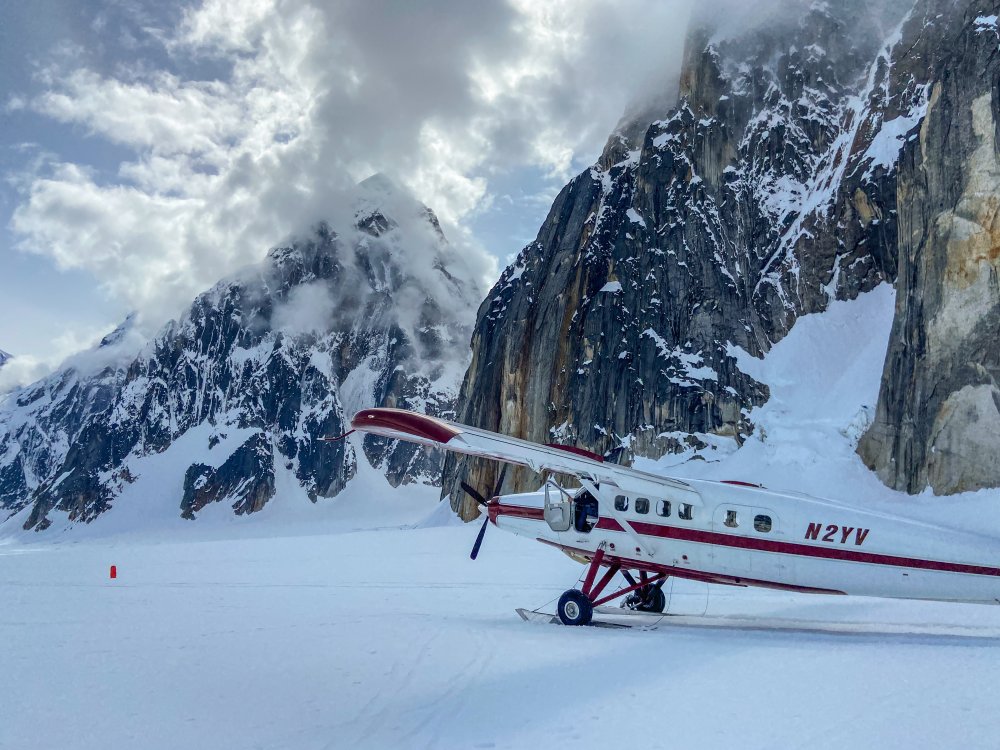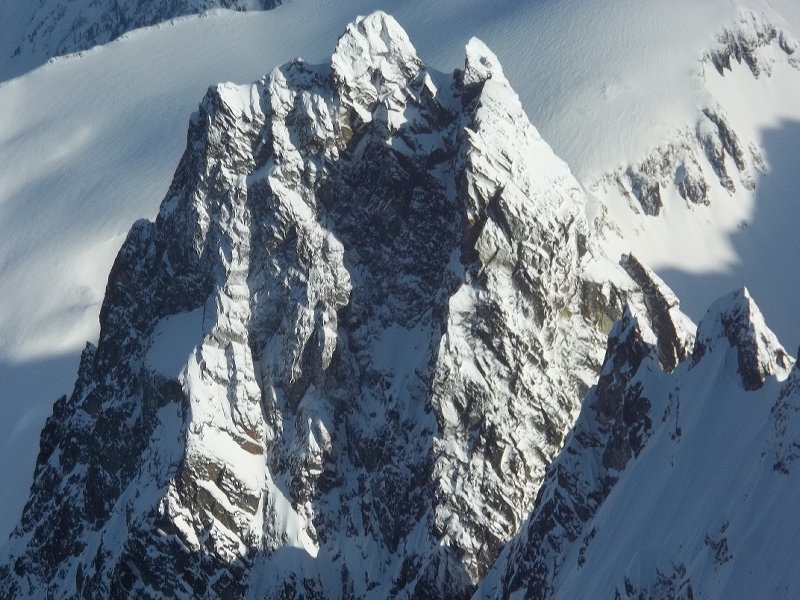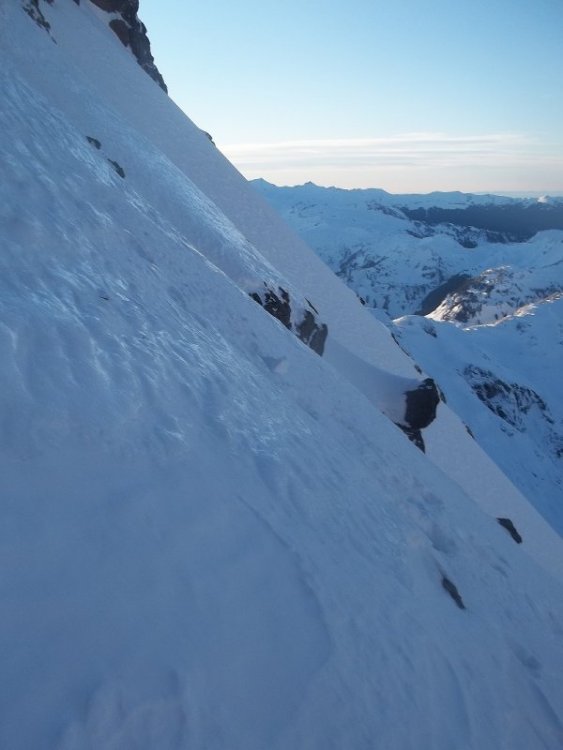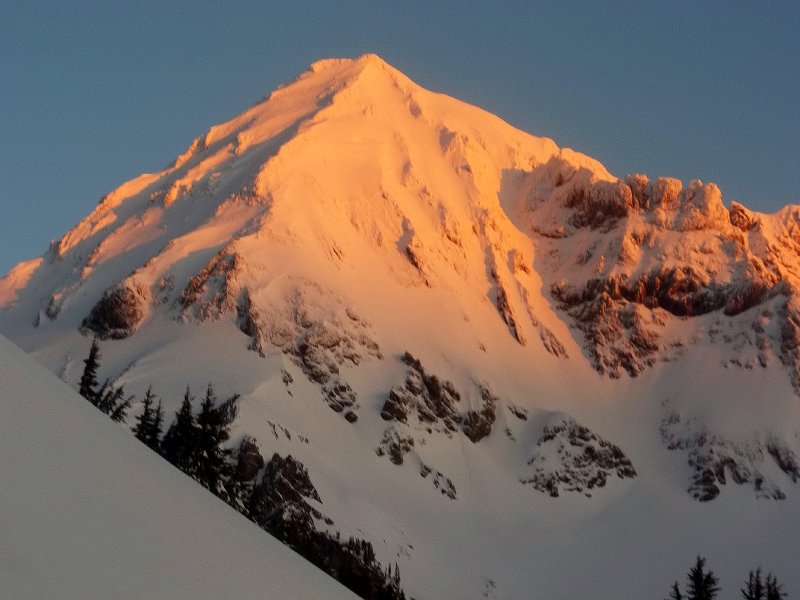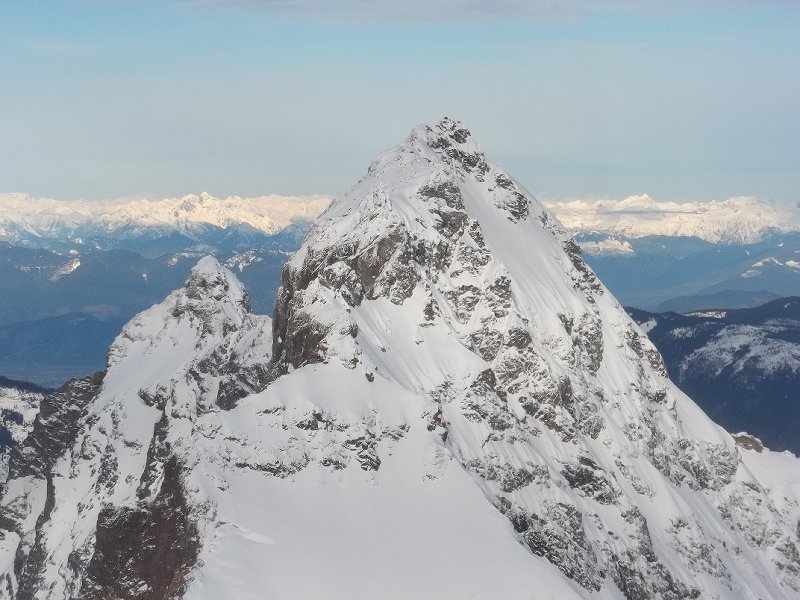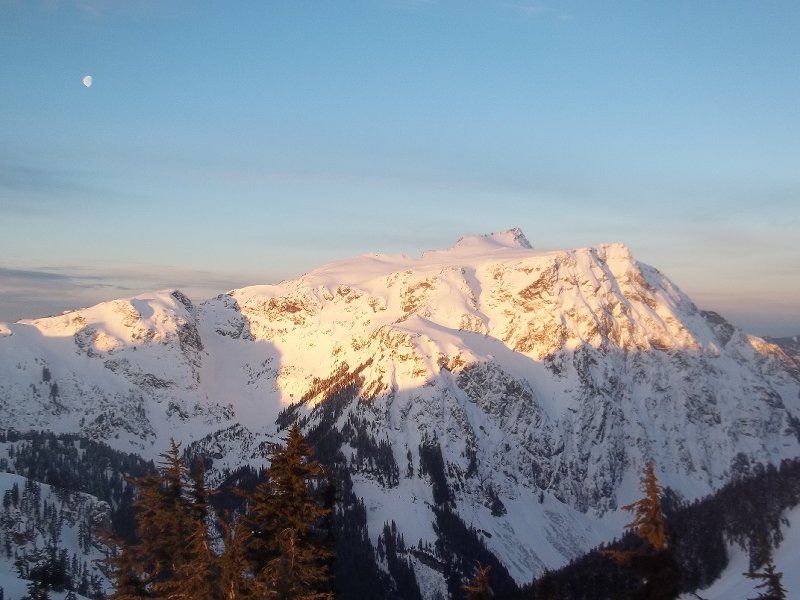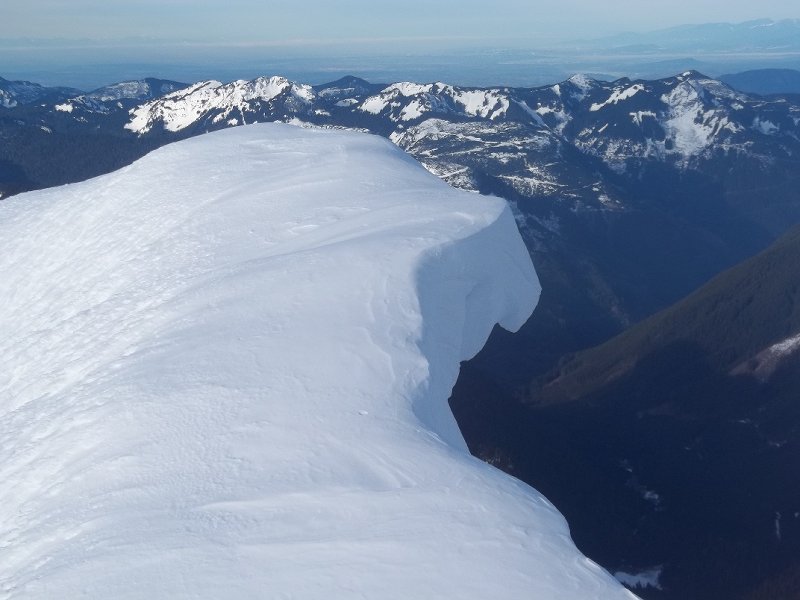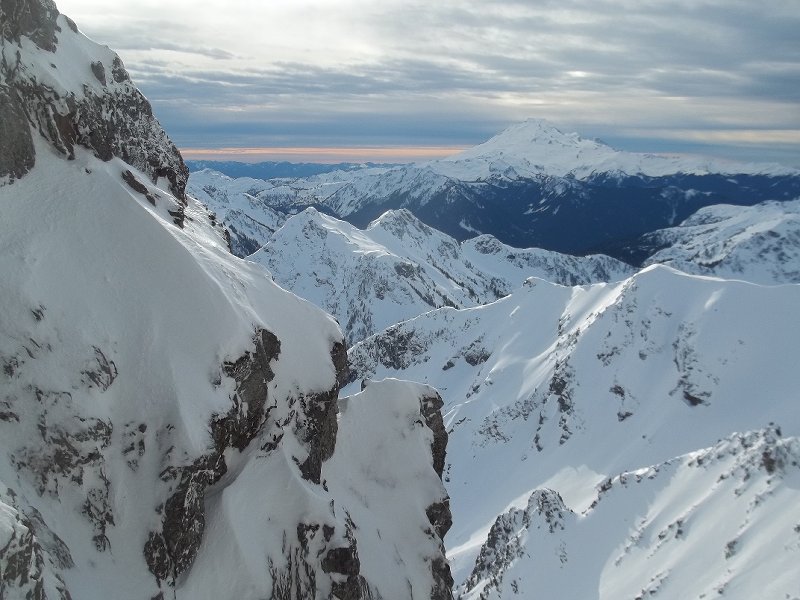Leaderboard
Popular Content
Showing content with the highest reputation since 04/03/24 in all areas
-
On April 13th Koby Y and I climbed what we believe is a first ascent on the far-left side of the Black Spider. We humbly submit this report for the historical record and for review by the fine netizens of cascadeclimbers. If you know of this line being climbed before, please let me know and I'll PRINT this trip report and then EAT IT (and appropriately redact our claims here). This route is labeled "waterfall" on the hand-drawn topo, left of the "waterfall" that later became the Fric-Amos route: Here's the route from the side, photo taken from the base of Cooper Spur in December (side note: despite looking fat in this photo, Fric-Amos was 100% unprotectable snice): This is a bit of a "lite"/"diet" Black Spider route, not tackling the entire face but rather topping out onto the Newton Clark Headwall about halfway up. Despite this, we did about as much technical climbing as on the neighboring Fric-Amos route and found it surprisingly engaging. It's a bit tough to grade as the ice was quite thin but we'd say it goes around WI4 with a couple M3-4 moves thrown in. I assume that like other routes on the Spider it could become easier and perhaps go entirely at WI3 in fatter conditions. On to some photos of the climb. Here is the face from below with the Arachnophobia second cliff band looking quite fat for April. Our route (which you can't really see as it's tucked in the corner) above the arrow: Next photo, approaching the route. There's currently a LOT of snow over there so the first steep bit visible in the side view above was totally buried. We just walked up into the little snowfield though there were a couple patches of low-angle water ice. Koby coming up into the snowfield: At the top of the snowfield we built an anchor and pitched out the rest of the climb. Here's looking down after the initial steep bit (WI4-ish?) of pitch 1: A couple photos from higher on pitch 1 below. Somewhat tricky climbing up a series of brief vertical steps with some thin/snicey/delaminating sections: I only led about 25 meters before building an anchor, as there was a patch of fat blue ice, a decent pin placement, and I guess I had already used all but one of my screws, sewing it up out of fear in my typical style. Here's Koby leading out above the anchor, about to do perhaps the hardest move on the route involving a brief torque in a horizontal crack to reach the good ice up above: Above this was mostly mellower, typical Mt Hood WI3-ish: Pitch 2 ended up being about 35 meters before joining the Newton Clark Headwall. In reality, we may have been able to squeeze all of our serious climbing into 1 60m pitch, though in more typical conditions (less snow) it looks like gaining the snowfield could require a bit of ice climbing, so it seems reasonable to expect to do at least 2 pitches. We simuled up the rest of the headwall, climbing one last short bit of WI2 between two gendarmes to join the upper Wy'East route to the summit: A couple final notes: First, thanks to Zach and Artem for trying to get this done with me the week prior. The wallowing was, unfortunately, insurmountable: Second, we did have one scary rockfall encounter that I feel obligated to mention. While belaying Koby on our second pitch, shortly after he topped out, a microwave-sized block spontaneously detached in the bowl above me and narrowly missed my head (I ducked), instead hitting my pack and ripping out the picket I had racked in the side pocket. A good reminder that climbing on the Spider sucks and to put the belays in more sheltered spots. This is really my fault for putting the anchor right in the fall line, I thought that we were much closer to the top of the route than we were in reality and that there wasn't that much overhead hazard. Thankful to emerge unscathed. Picture of the rock below: Thanks for reading.5 points
-
Trip: Williams Peak - Standard Trip Date: 04/13/2024 Trip Report: Over the past year of so I've gotten reacquainted with the Chilliwack Lake environs. It is just as close to my house as many areas of the Cascades and offers some new peaks to ponder and some unfamiliar views of familiar peaks. And, for whatever reason, I've been able to mostly have these mountains to myself on the handful of trips that I've taken up there. Williams Peak was no exception a couple weeks ago - I didn't see a soul after leaving the car. For such a striking peak on a fine spring day, I was a bit surprised. But there was definitely slogging, and that probably explains the solitude. The trail gains almost 3000' in the first mile and a half, and then there are two miles of undulating ridge to slog in snowshoes. But the scenic rewards, as you'll see below, were quite great beyond that. Plus, it did get more entertaining for the final 1000' up the steepening gully to the summit, dodging small wet slides and eyeing the cliffs above me suspiciously. I had read about annoying talus and steep heather once the snow melts off so a spring ascent might be the ticket on this one, even if it is more work. For me, being able to get a good look at the north faces of Rexford and Slesse draped in the think mantle of a late season snowpack more than made up for any discomfort. Williams from the valley bottom. Prepare to work! First glimpse of North side of Slesse: Chilliwack Lake: North side of Rexford with Shuksan in the distance: Slesse with Baker behind: Welch and Foley (gotta get in there next!): Look back at Williams from the slog out the ridge: Gear Notes: Snowshoes, I'm afraid. This wouldn't be a great ski with the up and down and endless forest. Crampons, helmet, and axe in early season- it is steep in the final gully Approach Notes: Chilliwack Lake Road is paved to the TH4 points
-
Trip: Black Peak and Prime Rib - #methowmultisport Trip Date: 04/20/2024 Trip Report: For those of us up here in the north sound, it is hard to ignore the gravitational pull when Hwy 20 opens for the year. It is like someone pulls the plug in the backyard pool and we are inexorably pulled east into the vortex of Sprinters and Teslas. But not this past weekend. It was like older, mellower times. Maybe it was the front moving through in the middle of the weekend. Maybe everyone was like my brother and were caught unawares of the opening? Whatever the reason, I'll take it. It was a good thing that the masses weren't up there though. @geosean and I myself weren't terribly original with the plan- a ski of Black on Saturday followed by Prime Rib on Goat wall on Sunday. We even brought bikes to enliven the descent from Goat Wall (this is a good bit more fun than rapping the route). And, mostly it went off without a hitch. And by that I mean we had fun, didn't get hurt, and came home friends. However, we did stop a few feet shy of the true summit of Black due to the typical spring shenanigans of steep snow, exposed rock, and no climbing gear. But, that slight disappointment was soon forgotten amidst the better than average corn skiing down to Lakes Ann and Wing. I think it has been over 20 years since I've been up on Black and I can see that I need to return more frequently. Thankfully the weather on Goat Creek Road was reasonable, though chilly, Saturday night. We started early to beat the crowds the never arrived and shivered in the wind and snow squalls as a result. It felt distinctly alpine, climbing in long johns and belaying in puffys all day. I'm sure it would be good training for something hard and high, if I still cared about those sorts of objectives. Mostly though, I shivered and muttered. But, it had been about 11 years since I had climbed the route, and so Prime Rib felt sort of like a new and interesting experience. This pronounced alpine amnesia is definitely one of the benefits of entering my "mature mountaineer" phase. Maybe I need to climb things all over again. Except Nooksack Tower. @geosean at Heather Pass: @geosean and Black at Wing Lake: I was not having this and turned us around: #methowmultisport: Dispersed camping views of Silverstar from Goat creek road: @geosean living the alpine dream on Goat Wall: The hordes will descend next weekend! Gear Notes: the full kit Approach Notes: Follow the herd3 points
-
I have climbed Ice cliff and stuart col. west ridge a few years ago in prime condition in middle april. I went in yesterday for a C2C and summited Colchuck to get a eye on things. Dragon tail has triple Col coming in the ice step is just starting to form, I would attempt it in the next few weeks. As far as Stuart goes, the end of april would probably be better. As of now the ice cliff and Stuart Glacier faces are loaded and probably full of loose dry sluff with a crappy crust. The summit block and ridge lines are in there winter state also. Gerber sink is not in a condition for screws. Hopefully this weather system keeps up and forms some better route conditions. Be prepared for the spring time afternoon high winds and crappy fronts that roll in this time of year. The gate at 8mile campground is still closed and will be for some time, I hit snow at about 1.5 mi in. It was about 1ft deep and consistent at the 2 mile mark. The trail is packed to the Colchuck intersection and easy travel in the cooler hrs. If you need a second reach out and I might be able to make it work, best of luck. will load pictures soon.3 points
-
Trip: Washington Pass - North Early Winter Spire: Early Winter Couloir. Trip Date: 04/21/2024 Trip Report: https://www.gorobets.com/TRs/Early_Winter_Couloir_2024_04_21.html Gear Notes: two 60m ropes cams 0.05-3 2 pickets small nuts pins (didn’t end up using) five screws 9-13cm Approach Notes: No flotation was needed.2 points
-
Drove up on Tuesday, April 23 to check on any winter's damage. The road to the parking lot is in great condition, with no new damage. Hiking up found a lot of new rocks have slid down into the area which has stopped all car traffic in recent years, about a quarter-mile up from the parking lot. I dragged many of them away to form a smooth path through the rock pile. Further up, used the axe to clear away several large alder and one fir log. The road/trail is now clear for bike riding to all turnoffs to the Squire Creek Wall routes. A huge log came down in the landslide area, pushing small alders over the trail: Further on, logs across the road were easily cut with the axe: I spent the rest of the afternoon moving rocks from the rockslide area just a quarter-mile above the parking lot. The resulting path is smooth but much higher than before; I'm not sure I can ride it with my meager bike-handling skills.2 points
-
2 points
-
Damn. That is crazy close to getting the chop. Glad you survived to post the TR!1 point
-
We should rename this thread to "North Cascades climbers to have more first world problems"1 point
-
1 point
-
1 point
-
Yeah shits been like that for a while my man. Sorry. Right now focused on keeping the site around, many sites have died, good ones. We are still going. I was working on getting a better TR system in place and made progress. But then that fell apart as the developer kind of went his own direction. You can still find stuff. And yes it could be better. I'm the only one running the site from the technical side. @JasonG and a few other mods keep things clean. Honestly I'd like to eventually hand the site over to a new guard of younger folks who will not commercialize the site and keep the community aspect alive...but also can make it better. Life has been taking me personally in a lot of different directions, but I still love this site and am committed to keeping it going. Also invite new energy and drive, but it has to be selfless, and directed towards keeping this going like a non-profit entity. Thankfully we have a great sponsor in the American Alpine Insitute, and we have had generous donations from the users of the site. There is a TON of great stories here, and they continue to grow. We will find a way to keep that alive.1 point
-
@Kameron yeah, I missed the presentations but Abram pointed out the other locations to me on a map later on at the meeting. You may be right about the multiple Heliotrope huts, not sure. In any case this is perfectly to your point about the vagueness of the whole enterprise. Also, if he didn’t mention those other shelters to the group at large, it contributes to the shady vibes I was referring to in my original post - seems like they’re happy to keep the other possible sites out of the public mind.1 point
-
And how are you sure of this? The NPS has shown in the North Cascades that they prioritize bears over recreation, most recently with the Terror basin closure this past summer. And yes, I am selfishly focused on recreation in our national parks, while you're focused on wildlife and think that is a superior attitude (by your lecturing and scolding of alternate viewpoints). Not quite sure how you figure who is superior in these arguments, but you seem to have drawn the line @jdj.1 point
-
Nor should it be. I've been around Grizzly bears nearly my whole life. I've worked in their habitat, I've recreated where they live, I frequently ski and climb in their backyard, etc. The amount of pissing and moaning on this thread is a disappointment. There won't be trails closed, there won't be any significant disturbance to your recreation, and you are not going to be torn to bits. Chances are in the Cascades you will never see one. Even here in the GYE we rarely do and we have somewhere north of 700 around here. In the old days most climbers and lovers of wild lands were, to some degree, conservationists. They supported national parks, public lands, and restoration of those lands. That seems to be less true today. Now it seems many want better trails and access but could care less about the land and ecosystem itself - sounds a bit selfish to me. Any by the way - money for trails does not come out of the same fiscal pot as money to restore bears.1 point
-
1 point
-
Some takeaways from the meeting this evening: I couldn't make the (sneaky!) 4 pm start time, so missed some of the presentations, but was able to speak to a number of folks about the proposals afterward. Basically, many of the concerns Kameron voiced at the start of this thread are spot on. - Most significant to me seems to be Aspire's plans to build not just a shelter at Heliotrope, but also one at Grouse Ridge and "a few" (Abram of Aspire's words) shelters at Artist Point. According to Abram, they would be running paid snowmobile shuttles to these shelters through the winter, and offering experiences to folks involving building fires and cooking food (read: glamping). They also hope to partner with guide services to offer ski trips and avy courses out of these shelters. Notably, the FS proposal only concerns itself with the Heliotrope shelter and many folks, including myself, were unaware of the other structures being pursued; when I asked Abram about this, he blamed it on the FS and took little responsibility for getting this rather critical information out to the user base. His arguments for the shelters centered on "spreading out impact" (not sure how running glamping trips on Heliotrope and Artist Point would be spreading out the crowds, personally) and the idea that lots of private companies make money off public lands, so why not them? A FS ranger told me that they are primarily considering the Heliotrope shelter first, and will make moves on the others depending on public comment and other vague provisos. - BMG seems to have zero plan in place for allowing the public to use their shelter, and they know that public use will be difficult anyway due to the logistics of reserving their shelter as a public user without official paid access to the Hampton land. And by "zero plan", I mean that BMG's owner said he literally hasn't considered it yet. BMG will pay 3% of their gross revenue to the FS for the land use. - the snowmobile club's shelter will be on wheels as stated in the proposal, and available to the public at any time. They'll pull it out every season once it melts out. - Roundhouse representatives weren't present, so not much information there. An interesting theme of the meeting was the general lack of information available about how these huts will benefit the public, how the commercial interests involved will run their operations, and how long these permits will be valid for. Numerous FS officials and guide service owners/reps had little to offer on these questions. The district ranger basically copped to a desire within the agency to make something happen with the proposal, whatever the outcome. We also caught the tail end of an interesting presentation on the possible impact on winter wolverine habitat, which would seem to mainly affect the Heliotrope site. Anyway, that's what I got. Sorry for the salty editorializing, but in my view this proposal is just ramrodding the interests of commercial enterprise down our throats with woefully insufficient information. I'm actually down with the snowmobile shelter, which has precedent in the Nooksack Valley and is being run by a nonprofit organization. The others are problematic, to say the least. Hopefully someone else can fill in the gaps that I missed or may have perceived differently.1 point
-
Wow, "reservable overnighting facilities operated by three private commercial entities" is exceedingly vague about who gets to use it. I feel like if you're going to allow any kind of development on public land it should be publicly accessible. The way I understood it last time was that the huts were going to be for private guided groups. I don't want more access for the rich pay to play crowd at the expense of any portion of the public trust. Cheap public huts like in Canada... maybe.1 point
-
28 Aug 2023 @Tom Beirne @Doug_Hutchinson Jason Niebler A survival climb, with interesting moves masquerading behind a feral crag, unwilling the be tamed. You can go in with all the iron and cams you want, but the flakes will flex and handholds turn to kitty litter. We were lucky to depart the falls before dusk, when it's rumored that Tin Cup Joe emerges with hatchet in hand and menaces trespassers. This rock appeared visually the cleanest in the area, especially compared to the rock immediately above the lower falls. The higher we trespassed, the lower the quality. This TR is intended to serve as a placeholder for the curious, and in our case, the stupid. This applies to the visible cliffs above the first falls all the way up to the upper slabs: don't bother. Picture below: first rock cliff above Tin Cup, lookin' sus. Approach. Don't approach. Turn around, do something else. Take the standard trail shown on Gaia up to the falls, then cross just prior to the first falls. A very faint trail can be barely followed left of the falls for a few hours. Cross both falls climber right and head towards the upper slabs, which you glimpses of during creek crossings. P1 5.7 40m to gear anchor belay on decent ledge. Begin up easy 5.7 slabs, through some shrubbery, and turn the lip of an awkward layback to the belay. P2 5.9+ 40m to hanging tree belay. Move belay to on top of tree with #1,2,3 crack directly above. Trend up and right through balance ledges through the green patch, and into the chimney for fun short boulder problem. Protects well in the chimney. P3 5.6 30m left trending diagonal traverse to visible tree. Couple pro options down low, none after about 15m. Mind the house of cards. RAP: Two Successive double 60m raps, each from stalwart pines. Apologies to the mountain gods for this transgression, we will seek absolution through worthy missions ASAP. Ps, Happy Birthday Jason, hope you liked your gift.1 point
-
Trip: Kangchenjunga - SW Face Trip Date: 06/01/2023 Trip Report: Kangchenjunga (28,169ft/8586m) Highpoint of India Third highest mountain in the world June 1, 2023 Eric Gilbertson On the summit (photo by Anna Gutu) May 27 – Heli from Kathmandu to Lukla, delayed by bad weather in Lukla May 28 – Heli to Tapethoke village, delayed there by bad weather May 29 – Heli to Kangchenjunga basecamp May 30 – Climb to camp 2 May 31 – Climb to camp 4, start for summit 7:30pm June 1 – Summit 5:30am, descend to basecamp June 2 – Heli to Taplejung, jeep to Suryodaya June 3 – Jeep to Bhadrapur, flight to Kathmandu June 4 – Flight to US Location of Kangchenjunga Kangchenjunga is the third highest mountain in the world and straddles the border between Nepal and India. It is officially the highest mountain in India, but is closed to climbing from the India side for religious regions. So it is only climbed from the Nepal side. The name means “The five treasures of the high snow” and indeed the peak has five sub summits. This very often leads to confusion with climbers taking routes to a summit that is not the true highest point. Aside from routefinding issues, the normal route to the summit is technical with steep rock and snow sections. I was in Nepal for the spring and my goal was to climb Mt Everest and Kangchenjunga. I’m working on climbing country highpoints and this would theoretically get the highpoints of China, Nepal, and India. The normal climbing season for both peaks is mid/late May, and it is difficult for me to get time off this time of year due to my teaching schedule. So if I could get time off for one peak I might as well try to squeeze them both in. The route I officially got time off to climb Mt Everest, so I needed to go for that one first. Then if I happened to finish that climb early enough, was still feeling ok, and the monsoon and high winds hadn’t yet started yet, then I could give Kangchenjunga a shot. I would theoretically already be acclimated so Kangchenjunga should only take a few extra days to climb. I arranged logistics with the cheapest company I could find, Seven Summit Treks, and paid for basecamp services for each peak and helicopter transportation between basecamps. I was planning to climb both peaks without supplemental oxygen and without personal sherpa support, just on my own above basecamp. This was mostly to save money so I could afford both peaks in the same season. I had previously climbed K2 this way in the summer of 2022, so the strategy seemed feasible. Climbing with supplemental oxygen and personal sherpa support significantly increases the price. Flying out of Kathmandu Three partners – Matthew, Steven, and Darren – would join for Everest, but I would be on my own for Kangchenjunga. On May 22 I made my solo no O2 summit attempt on Mt Everest, but had to turn around at 8500m after showing signs of HACE. I had been troubled by a dislocated shoulder in the Khumbu Icefall, two weeks of being sick from a respiratory infection, and not enough time for all the rotations I had intended. Unexpected wind had then delayed my summit push making me spend 40 hours above 8000m without oxygen and pull two consecutive all-nighters before moving up from camp 4. It seemed like luck was not on my side that attempt, though I did make it back down unscathed to basecamp with just a bit of sunburn on my nose. The Khumbu Icefall was effectively closed a few days after I descended (ie all ladders across crevasses were pulled), meaning there was no time for another attempt, unfortunately. After hiking two days down to Lukla I caught a late-morning flight to Kathmandu May 26 and considered my options. Flying to Lukla I was using weather forecasts from professional meteorologist Chris Tomer, and he told me there was still a summittable weather window on Kangchenjunga in late May and early June. It appeared the weather on Kangchenjunga was a bit different than on Everest, since the Everest season effectively ended May 26 due to increasing winds. I had already paid for permits, transportation, and logistics support for Kangchenjunga. And I was already acclimated. The elevation I had reached on Everest was approximately the elevation of the summit of Kangchenjunga. The only potential reasons not to go were that I was still exhausted from Everest and the hike out, and I might end up being alone on the mountain. But I had heard that a group from Elite Expeditions was planning to head from Everest directly to Kangchenjunga, so I wouldn’t be alone. And perhaps if I rested a few days I could regain some energy. I met in person with Dawa and Thanes from SST shortly after landing. It turned out there were currently two solo no-O2 clients of SST in trouble on Everest and Kangchenjunga and rescue teams were being sent to help. Suhajda Szilard, who I knew from basecamp and some of my rotations, had attempted to climb Everest solo with no O2 two days after me on May 24 but had not made it down. He was last seen laying down below the Hillary Step. SST was scrambling to send a rescue team to find him (the search would end up being unsuccessful). Also, skier Luis Stitzinger had failed to return from his solo no-O2 summit bid on Kangchenjunga also on May 24. SST was currently organizing another rescue team to look for him (he didn’t survive and his body was later found at 8300m). With this situation unfolding, understandably SST did not want another solo no-O2 client up on one of those mountains. I was told I needed to go with sherpa and supplemental oxygen. I was confident I was acclimated enough to summit without oxygen, but it appeared my options were to either summit with oxygen and personal sherpa or go home and lose all the money I’d already spent on permits and logistics. Grounded in Tapethoke village It would cost another $11k to hire sherpa and oxygen for Kangchenjunga, and I could just barely afford that if I zeroed out my bank account. That would be cheaper than losing all the money I’d already invested and then paying more a future year to come back, so I reluctantly agreed. Dawa made some calls and indeed a team of four clients and eleven sherpas from Elite Expeditions was planning to helicopter to basecamp the next morning and start a summit push. I would have the highest chance of success if I went on the same schedule as that team. I would go with Pemba Sherpa and he would bring three oxygen cylinders for me to use on summit day. He would bring a spare regulator and he knew how to fix any issues with the system. Approaching basecamp So I had that afternoon and evening to quickly cram in some resting and eating before heading out at 5am the next morning. Most of the SST climbers were back from Everest now and everyone was at the Fairfield or Aloft hotels. It appeared I was one of the few cheapskates who hiked out and most other climbers helicoptered back from basecamp. I met up with Matthew and Steven for a big Indian lunch, then Steven and Elena for a buffet dinner at the Aloft hotel. I tried to cram in as much food as possible since I’d lost a lot of weight on Everest, but it’s not possible to make up for all that in just two meals unfortunately. Made it to basecamp After dinner I quickly repacked one duffle worth of gear for Kangchenjunga. Unfortunately one of my bags of gear was still stuck at Lukla, but Steven lent me crampons, harness, and helmet just in case I couldn’t recover my gear. May 27 The next morning I left the hotel at 5am and met up with Pemba and a three-man rescue team at the airport. We would all head to Kangchenjunga together. We crammed our packs and gear into a helicopter and soon took off. The plan was to stop at Lukla, which was on the way, then change helicopters and continue. It was a scenic one-hour flight, and we soon made it to Lukla in increasing clouds. I found my duffle in a pile of bags under a tarp outside the airport, and switched out my crampons/harness/helmet from the bag for Stevens. I was soon ready to go again, but the weather had different plans. The clouds got thicker and it started raining. I hung out in the helipad terminal with a bunch of other climbers killing time. I’ve found that basically all expeditions are characterized by the “hurry up and wait” situation. That morning I had rushed to make an early morning flight, only to wait and kill time the rest of the day. Indeed, the weather never improved, and I spent the whole day milling around the terminal killing time. In basecamp By 4pm Pemba made the call that it was too late to fly out and we needed to spend the night in Lukla. We walked over to the Everest House Hotel, ate dinner, and soon went to bed. I was instructed to be back at the terminal ready to go by 5:30am the next morning. May 28 I got to the terminal a bit early at 5:15am, and was of course the only one there for the next hour. The weather was still socked in, and I suppose I could have easily slept in a lot longer. Over the next few hours some climbers trickled in, until the terminal was full by 11am. The clouds gradually started lifting and a few helicopters flew in and out. By mid afternoon the SST helicopter made it to the helipad. It had to make a few trips before it could take us last, though. It made a shuttle trip to Namche first. Then they removed all the seats to save weight and headed up to Camp 2. The rescue team looking for Szilard on Everest had made the summit but found no trace of him, unfortunately, and had descended back to Camp 2. The Khumbu Icefall had been closed by then with all ladders removed, but the team got extracted by the helicopter from Camp 2 back to Lukla. By mid afternoon it was our turn. I loaded up with Pemba and the rescue team and we finally took off. We headed due east in marginal weather, zipping above jungle and villages. We went for around an hour, starting to head up valleys to the northeast, but then the pilot suddenly descended and landed on a small helipad at Tapethoke village. The pilot had been on the radio with a pilot from an Elite Expeditions helicopter up ahead of us and the weather was too bad to make it to basecamp. The other helicopter had been stopped at Tseram, so we decided to stop there. In basecamp A few locals got out to help direct the landing, then they showed us to a small guest house. The village was pretty small and I bet they don’t see too many outsiders. There was a very rough jeep track going through, so it is accessible, barely, by road. They killed a rooster and we had chicken soup with dahl bat that night. The sherpas tried to convince me to eat sherpa style with my bare hands but I managed to find a spoon to eat with. It seems a lot cleaner to eat rice with a spoon to me. May 29 The next morning the skies were clear and we took off at 5:45am. It was a short and scenic flight up the valley to the edge of treeline at Tseram at 3700m. The helicopter couldn’t go fully loaded all the way to basecamp at 5400m so had to make shuttle runs from there. We unloaded everything, then Pemba and I got in with our gear while the rescue team waited. We helicoptered up to 5400m and landed on a small pedestal of rock sticking up from basecamp. The view from basecamp The basecamp location was amazing. It was a peninsula of rock jutting out between two glaciers and sticking up enough that it was sheltered from any avalanches from above. Even at its height there were small patches of grass growing on it. Kangchenjunga loomed above behind camp, and yellow tents were scattered all over the peninsula. It appeared only Seven Summit Treks and Elite Expeditions still had camps there. A handful of climbers were milling around, having recently successfully summitted. I got out and soon ran into Flor, whom I’d met on K2 last year. She’d summitted a few days earlier and had known Luis, the climber the rescue team would be looking for. There were a half dozen climbers all getting ready to fly out on the same helicopter. Lots of Sherpas would stay to run the camp while we were there. I was ushered into the dining tent and served a great breakfast. I stuffed as much food down as possible since I was still kind of in recovery mode from Everest. The helicopter did one more shuttle run and got the rescue team in, then shuttled a bunch of climbers out. More basecamp views The rescue team quickly packed up and started up, but it didn’t seem like Pemba was in much of a hurry. It was only 7am and there was plenty of daylight left, and the weather was perfect. My forecast from Chris was for great weather today, and sunny for the next four days, but increasing summit winds each day. It seemed to make the most sense to me to summit as soon as possible before the winds got too high. I told this to Pemba and he went and talked to the Elite Expeditions team, which had just arrived. Their plan was to take a rest day in basecamp and start up the next day. This didn’t make any sense to me. All packing could be done within an hour and we would have plenty of time to make it up to camp two or three. We had just rested the past two days with the bad weather delays. The rescue team had just started up and they were planning to make it to camp 3 that night. But since the Elite Expeditions team wasn’t going up we had to also wait. This is one reason I like going unguided, so I can make all decisions on my own. But I was basically obligated to go with everyone else. So I reluctantly unpacked my gear, found a tent, and tried to nap the rest of the day. I suppose one good thing about all these delays was that I actually got three unexpected rest days, which I probably needed anyways. And the delay in Tapethoke village gave me another night at low elevation, which probably helped with recovery. Hiking up to camp 1 The Elite Expedition Sherpas were planning to move to camp 2, then camp 4, then summit June 1. Chris’s forecast was for summit winds 25-35mph on June 1, which seemed marginal. Generally I want winds less than 20mph for summitting without O2. With O2 I’ve heard a common threshold is 30mph. Supplemental oxygen warms the body up so you can tolerate more extreme wind chills. So June 1 would be marginal while May 31 would have been acceptable in my view. But the Elite Expedition Sherpas said the route up the southwest face is generally sheltered from the winds, so you really just experience them briefly on the summit ridge. Chris confirmed the winds were indeed from the WNW and that ought to leave most of the route sheltered. The sherpas had done this mountain plenty of times so I had to trust they knew the conditions. May 30 The next morning we got ready early and by 8:30am the Elite Expedition team started up. So we started up behind them. Pemba and I split the group gear (tent, stove, fuel) and he said the rescue team had taken up a few extra oxygen cylinders. Still, my pack was around 65 pounds with the down suit, -20F sleeping bag, and tent strapped on. Nearing camp 1 I noticed the clients with Elite Expeditions didn’t seem to be quite as loaded down. They just had small day packs. It appeared there were a lot more sherpas in that team to help carry gear. There was even a professional photographer along and a few guides! I’m quite certain I paid a lot less than they did, though, and I was fine with carrying all my own gear. Despite this, Pemba and I still somehow managed to pass most of the climbers and ended up near the front of the pack. We started out hiking through a talus field, then went up a gradual snow slope and eventually hit a set of fixed lines. The slope was steep enough that you didn’t want to fall, so I was happy clipping my ascender on. It made me a little nervous that most of the sherpas tended to just clip a beaner on but not their ascender. This meant if they slipped nothing would stop them and they would run in to the climber below. In fact, I’d heard on Dhalguiri earlier this season a sherpa in this situation had slipped, crashed into the climber below, and broken his leg! Traversing to camp 2 Luckily no incidents like that happend on this trip. We made steady progress up the snow slope, which eventually got quite steep. We then made a long traverse and hit camp 1 at 6100m on a ridge. I’ve heard camp 1 is really just used on early acclimation rotations, and indeed there was no evidence left of a camp there. We stopped briefly for a snack break, then continued. From that ridge the route actually descends a bit to the glacier below and very soon reached camp 2. We dropped down the opposite side of the ridge and arm-wrap descended a gradual slope. I rappelled one short and steep dirt section down lower, then made a short and flat hike to camp 2 around 2pm. It was only about an hour between camps 1 and 2, so I can see why camp 1 soon gets skipped. Camp 2 was on a large flat section of glacier at 6200m and looked very safe from any rock or ice fall. There were already three tents set up there from Satori Expeditions and 8K, and I think Elite Expeditions had arranged for those to be left there for them. The other climbers jumped in those tents while Pemba and I set up ours. I’m glad we brough the SST tent because it weighed about the same as mine but was 50% bigger! Camp 2 We soon threw our stuff inside and Pemba started melting snow. A steep icy headwall loomed above between us and the summit and I could make out an orange tent on a bench near the top. That was camp 3, where the rescue team had made it the previous night. Higher up in the distance we could make out a snow gully leading up towards the summit, and there were a few climbers in it. That appeared to be the rescue team searching for Luis. We rested the remainder of the afternoon, and after an early dinner went to bed at sunset. May 31 The sun woke us up at 4:30am and we were soon packed up. This time we all started out in down suits and I left some extra gear to try to save weight. Pemba advised that I could just wear a base layer under the down suit and leave my jacket, snow pants, and extra layers behind. On Everest I had worn absolutely every layer and been barely warm enough, but I guess breathing supplemental oxygen would take care of keeping me warm. Climbing up to camp 3 The thought had crossed my mind to just hang the oxygen mask off my neck and not use it so I could still get a no-O2 ascent. But the more I thought about it the worse that idea seemed. We were already planning to go up in conditions that were too windy to safely go without O2 in my mind. Pemba said the group planned to start at 7:30pm that night to summit at sunrise. That gauranteed going mostly at night, when I was at most risk of getting frostbite with no O2. I would really want to start more like 1am to minimize time at night, but I had to go with the group so that was not possible. Also, I would be carrying two oxygen cylinders, which each weighed 10 lbs. It would be silly to carry 20 lbs of unneccessary and unused weight on my back if I didn’t use the O2. I couldn’t just leave the O2 and go on my own schedule because SST had told me I was required to go with O2 and sherpa. So I was basically cornered into going with the group with the O2. At least it increased chance of success, even if a bit less honorable than I had hoped. So I ditched the unneccessary gear, and since I wore my down suit my pack was considerably lighter. I kind of wanted to leave my sleeping bag too, since we only planned to rest a few hours in the daylight and not sleep at camp 4. But based on my experience on Everest pulling all-nighters at camp 4 there without a sleeping bag I figured it was wise to bring it just in case plans changed and we ended up needing to sleep at camp 4. Above camp 3 By 5:30am we rolled out of camp and started up the flat glacier. As before, Pemba and I soon found ourselves near the front of the pack. As we reached the base of the steep headwall we saw the rescue team of four sherpas coming down. They were dragging something in the snow and that didn’t look good. As they got closer I could tell it was the body of Luis wrapped up in a tarp. It had been nearly a week between his accident and them arriving due to the weather delays, so I suppose it had always been unlikely they would find him alive, unfortunately. We jugged up the steepening ice and snow slope, and it soon leveled out just below camp 3. A small ice avalanche had wiped out part of the fixed lines there, so we had to unclip briefly. Higher up I took a few ice screws from a sherpa and built some new anchors for the rope and did some re-directing to make improvements. We soon reached the small bench that is camp 3 and took a break. By this point some of the Elite Expedition clients had already started using oxygen, I think starting around 6500m. The plateau at 7100m There was a single tent there and some Elite Expedition sherpas took it down to move it to camp 4. They had really planned things out well, having tents left on the mountain for them so they didn’t have to carry as much from basecamp. The route got quite steep just above camp 3, but then did some traversing and climbing over small shoulders. Eventually Pemba, I, and Dawa were far in the lead and Pemba took over breaking trail. The rescue team had been up there that morning but the wind had drifted their tracks over. When we hit 7100m the slope leveled out to a big bench and I mistakenly thought this was camp 4. But Pemba said it was the next higher bench. We took a brief rest then continued. The route dropped down into a small valley then ascended up a steep ice slope. There were no steps kicked in and we took turns on the rope. Just around the corner from the ice slope we finally arrived at camp 4 at 7300m by 2pm. The short descent before camp 4 As before Elite Expeditions had an 8K tent already set up waiting for them. Dawa jumped inside while Pemba and I kicked out a platform and set up our tent. The slope wasn’t too steep, but it did still take a lot of effor to kick out the platform without ice axe or shovel breathing the thin air at 7300m. More Elite Expedition crew soon showed up, and everyone except me, Dawa, and Pemba was breathing supplemental oxygen. I was feeling pretty good at that elevation. I’d already spent about 48 continuous hours above 8000m without oxygen on Everest a week ago so 7300m wasn’t a problem. Dawa had been very generous to melt us some snow while we were making our tent platform, so we threw all our gear in the tent and laid down to rest. Pemba put his oxygen mask on and started breathing, but I thought I should save any oxygen for summit push emergencies. And I was breathing fine anyways. Arriving at camp 4 Pemba then gave me a lesson in how to use the system. I’d never used oxygen before so had no idea what was going on. He had brought a third regulator as backup, which comforted me. We tested that two cylinders fit in my backpack with the pressure valves visible. He showed me how to put the mask on, and said I shouldn’t wear a helmet since that made taking the mask off to eat or drink difficult. I said I didn’t care and I was definitely going to wear a helmet. There’s always risk of rockfall or icefall in the mountains. I said if I was thirsty I’d just take the helmet off then take the mask off. The regulator went in increments of 0.5L/min up to 4L/min flow rate. I’ve heard more expensive setups go up to 8L/min and lots of Everest climbers use that flow rate. But that means they need to have more cylinders brought up. Pemba said 2L/min would be a good rate and that should last 6-9 hours. We would start that immediately and that would probably get us to the summit. Then we would switch to a second bottle for the descent. I would carry both bottles, and he would carry a third as spare just in case. Then he would just use two. I think the plan was each of us would just use two but the third was a spare for either in case of emergencies. Testing out the mask I’ve had multiple friends have their regulators break on summit push on Everest. I also heard Darren had his oxygen run out before his sherpa noticed on his Everest push and he was feeling pretty crappy and starting to black out before it got switched. These stories make me nervous about relying on a mechanical system like that when unacclimated. I was comforted by several facts, though. I was already acclimated enough to summit without oxygen, so would be perfectly fine if the system didn’t work. I just might move slower and get colder. Pemba had a spare regulator that we verified worked. And, we were with a big group so among all of us there were plenty of spare components and cylinders. We took naps in the afternoon, then had an early dinner. I had a very strong appetite and had no problem finishing my two packs of Ramen noodles and quarter pound of extra sharp cheddar cheese. I don’t often have that strong an appetite above 7000m, so this tells me I was in fact very well-acclimated. By 7pm the sun set and we started getting ready, and by 7:30pm we were out of the tent and moving at the back of the big pack of 15 other climbers. Starting out just after sunset This was the first time I had breathed supplemental oxygen, and I was very curious how it would affect me. I’ve heard people say it lowers the apparent altitude by a few thousand meters, so I expected to feel like I had down at basecamp. It was still kind of hard work walking around down there with a pack so my expectations weren’t too high. Maybe it would help an extra 20%. What I actually experienced felt like an extra jolt of energy with each breath. After a few steps I’d get a little tired, then I’d suck in a breath and instantly be back up to full strength with energy ready to power forward. I kind of thought of myself like a cyclist on EPO in the Tour de France. I basically had unlimited energy, and something felt not quite right about that, like I hadn’t earned it. Hiking up with the EE team I could basically go twice the speed as I could without supplemental oxygen, and never got tired. And this was on a modest 2L/min. Could people on 8L/min on Everest be getting 4x the extra energy boost as me? I’m not sure if it scales that way, but no wonder oxygen use is common 8000m peaks. I think the only people that truely understand this advantage are the ones that have climbed 8000ers without oxygen and also tried it with oxygen. (I’d previously climbed Broad and K2 without O2 and gotten to 8500m on Everest without O2). As an added bonus, my fingers and toes never got cold. Not even a hint of being numb. If I was without O2 like on Everest I’d have to be stopping every 10 minutes to warm things up. But now I could just go continuously for hours, never needing to rest or warm up appendages. In my experience it is an order of magnitude easier to climb with supplementary oxygen than without. For better or worse, I was definitely going to make the summit this time. Looking back towards Jannu in the moonlight We generally stayed together as a big 17-person group down low, and I commend the sherpas in the front for breaking trail. Fortunately the tracks from the rescue team were still around so I don’t think it was quite as bad breaking trail. As we got higher the team started spreading out, with two EE sherpas and client in the front, then me, Pemba and Dawa all making up the lead group. Behind us the remaining climbers started slowing down more. Progress was slow and steady, and we didn’t stop for any breaks for the first five hours. That’s the power of supplemental O2 for you. By 1am we took a 5-minute break to eat some snacks, and then a few hours later we stopped again for a quick water break at the base of the rocks. Navigation can sometimes be problematic on Kangchenjunga I’ve heard, but an advantage of us coming at the end of the season was that other climbers had already figured out the route and left the fixed ropes there for us. We just had to jug up them. Sunrise on Yalung Kang June 1 The steep snow slopes got a bit tedious but then around 3am the climbing got more interesting when we hit the base of the rock band. There was a little bit of a traffic jam going up but when I got to the rocky section it just seemed like fun scrambling to me. Maybe that’s since I do a lot of mixed climbing in the winter in washington that I knew exactly how to wriggle up the features. We crested one rocky section, then started a traverse. We were then stalled a bit as the three lead climbers figured out a way up a tricky section. By then it had been 8 hours and I was worried about my oxygen canister running out at in inconvenient spot. Since we were already stopped I asked Pemba to check, and indeed it was about empty. He quicky switched the hose to the other canister and we continued up. Hiking up the final snow slope We scrambled up one final rock section then topped out on a snowy ridge just as the sun was coming up around 5am. From there it was a short snow traverse, then climbing up another short steep snow slope to the final summit pyramid. We traversed on rocks around the base of the pyramid, passing one old dead body lower on the rocks. Up until that point the wind had been mercifully light, but above us on the summit it looked like it was ripping very fast. Maybe Chris’s 25-35mph forecast was actually an underestimate! Though he did say it would be at its lowest at 6am, and it was almost that time. The group of three in front of us crested the ridge and I soon followed. Amazingly, once I poked my head up over the ridge the wind seemed to die down and was almost calm! I had feared it would be a knife-edge rock ridge but, while my side was all rock, the other side was a gentle snow slope. The final rocky bit before the summit I easily marched up the snow slope and reached the summit at 5:30am, ten hours after starting. I was the second one up there. The photographer for Elite Expeditions had gotten their first and was waiting to take pictures of the clients. Conditions were perfect. Only partly cloudy with great views around, almost no wind, and not even too cold (probably because I was breathing the oxygen). I got a few pictures and a brief video, then Anna Gutu from EE made it up and I took some pictures of her. She returned the favor for me, but then my camera froze and wouldn’t turn on! I thought keeping it warm in my inner pocket would help, but I guess it was actually kind of cold up there (forecast -15F) and it had gotten too cold. The only way to salvage it in this situation I’ve found is to plug it in to an external battery. But I didn’t want to fool around with that on the summit so I called that good enough for pictures. I yielded the top to the other climbers coming up and stood off to the side admiring the view. But I soon started getting a little nervous. More and more climbers were trickling up and it seemed risky somebody would knock another person over the edge with all the jostling for pictures. So I told Pemba I was good and we should head back down. On the summit Ten minutes had been plenty up there to admire the view, plus if we were the first ones down we could rappel all the steep lines and not have to wait in a queue. This would be especially important if the weather turned sour, and it was indeed supposed to get windier over the day. We made fast progress down, and took turns rappelling the steep lines and arm wrap descending the others. Pemba was much faster so he went first, and we soon spread out enough that I didn’t have to wait at all to rappel. At the base of the rocky section I noticed a pack sitting by itself in the snow with a set of skis sticking up next to it. This must have been from the climber Luis that the rescue team found. Way lower on the slope I had seen a few stuff sacks earlier, also likely from him. I arm wrapped down the snow slope, though managed to rappel a few of the steeper sections. By 8:30am, three hours after summitting, we both staggered back into camp 4. It felt good to pull off the oxygen mask and finally be breathing normally. It turned out we had a lot of extra oxygen. I had only used a little over one canister and Pemba the same. So we had a few extra canisters. There was no need for any oxygen going down, and empty canisters are much lighter, so we opened the valves and released the extra gas. It felt kind of wasteful, but didn’t make sense carrying so much extra weight down. Back at camp 4 Pemba proposed a two-hour break, then we would descend back to basecamp. So I repacked everything, then laid down for a brief nap. We had just pulled an all-nighter so both appreciated the rest. By 10:30am we got out of the tent and started taking it down. There had been a suggestion that we just leave the tent there, but there were no other teams coming up that season that could use it, and it would just become trash. I volunteered to take it down since I’d carried it up. By 11am we were all packed up and heading down. My pack was now monstrous again since it was too hot to wear the down suit and I had to put it in the pack. By then some of the EE team had made it back, but most were still working their way down from the summit. I think our time of 3 hours down was kind of fast. Descending back down We made good time down from camp 4, again enjoying the benefits of being first since there were no queues to wait in and we could rap down any line we wanted. (For reference, two people can climb up a rope at the same time but two cannot rappel down a rope at the same time – they must take turns, which can slow things down descending). We passed through camp 3, then took an extended break at camp 2. It was getting hot and I was out of water by then. The rescue team had been in camp 2 the previous day and was hoping for a helicopter extraction, but for some reason conditions weren’t good and the helicopter couldn’t land. So they had moved everything to camp 1 and would get extracted from there. Meanwhile, they had generously melted a pot of water and left it for us, and left a bag of coke bottles for us! Last look at the upper slopes I chugged the water and Pemba cracked open some cokes. I don’t really like carbonated beverages, but I was low on energy and liquid and figured the sugary beverage might help. Pemba passed out more cokes to EE sherpas coming down and everyone was in good spirits. Some clients came down and took naps in the three tents remaining there, and Pemba and I soon packed up and headed out. I really was not looking forward to the uphill to reach Camp 1 after already putting in a big day. I think the coke didn’t agree with my stomach since I don’t usually drink carbonated bevereages. At any rate I was not feeling 100% approaching that hill, and it took me twice as long as it should have to make it up. Descending below camp 1 I eventually made it and caught up to Pemba resting at Camp 1. From there it was easy arm wrap descending down. A few sections of the route had been hit by small loose wet avalanches, likey earlier that day. It was indeed kind of hot there in early June. But by the time we got there evening clouds had built and the slopes were stable. We dropped back down and eventually staggered in to basecamp around 530pm for a 22 hour day. We had an excellent chicken and spaghetti dinner, and I even got to take a warm bucket shower before bed. June 2 Back to basecamp for dinner An Elite Expedition helicopter arrived at 6am and immediately started shuttling climbers out. That would be the only helicopter and it had to service everyone. I quickly packed up and took my turn to shuttle down to Tseram. There we all waited for a few hours drinking tea at the local teahouse. When all the climbers and sherpas were out the helicopter then started shuttling us all to the Taplejung air strip. This was the closest village with a paved road to basecamp. I had been told the whole SST crew would get flown to Kathmandu that morning. This was important since I had purchased a flight out of Kathmandu for that evening. I had purchased it just before heading in to Kangchenjunga, and thought building in four buffer days would be enough. But with the weather delays and the delay in starting out of basecamp it had eaten into my buffer time. The flight could still work, but then Pemba told me we would not in fact be going to Kathmandu that day. The one helicopter would take the elite expedition clients back, but the sherpas and I would be taking a 10-hour jeep ride to the nearest major airport at Bhadrapur and taking a scheduled fixed wing flight to kathmandu the next day. Flying out That was a little frustrating, but I guess it was my fault for not building in enough buffer days. I called up the airlines and it turned out the flight cancellation fee was almost exactly the price of the flight. So I basically lost $1000 by that mistake. However, I decided I’d rather stick it to the airline and just not show up instead of cancelling. That way they couldn’t resell the ticket to make more money. I lost an extra $30 or so but it felt worth it to me. I figured I basically gained $1000 by hiking out of Everest basecamp instead of flying out, so maybe now I was even. That afternoon Pemba and I hopped in a jeep with the rescue team and we started the long, windy drive out. We crossed mountain passes and dropped way down to cross river valleys. Basically the whole way was blind turns on the side of cliffs down in the jungle. Eventually we reached Suryodaya eight hours later and stopped there for the night. June 3 The next morning we drove two more hours to Bhadrapur, then got on the 9:30am flight to Kathmandu. In Kathmandu I took a taxi to the Fairfield Hotel, and Thanes brought over my bag that SST had gotten from Lukla. I had enough spare time to meet a friend Sandro for dinner, then made my 2am flight back out for Seattle. Gear Notes: Standard 8000m gear Approach Notes: Helicopter to basecamp1 point
-
well that makes it a moral conundrum. bought with private funds but sits on public land. seems like it could go either way. would be cool if let unlocked and accessible when not occupied by the guide services. or of fee required, it would be fairly cheap like the Canadian BC hut systems, but I think the alpine club runs those so the motivation is different.1 point
-
Conflicted on this. if the structure was completely paid for by the guide service then i can see that they have control over it. but then it is also on public land. But then if some jackass leaves the door open in the winter and the inside fill up with snow. in the description "provide temporary winter shelters for the recreating public (both commercially guided and unguided). Three of the shelters would provide reservable overnighting facilities operated by three private commercial entities. One of the shelters would provide a free warming shelter day-use for the general public. All of these shelters would provide safe locations for the recreating public during the winter season." it doesnt say who is paying for it.1 point
-
I would love to see the Enchantment lottery run more like hunting tags. Your chances go up the more years in a row you try and don't get a permit, and if you get one, you have to wait years before you can get it again (maybe once per lifetime even).1 point
-
"something felt not quite right about that, like I hadn’t earned it." Hahahaha, nice. I wouldn't have expected anything less from you Eric! Glad you made it at least even if it wasn't exactly your style. I bet Pemba was thrilled to have you as a client on that one! I assume you're way less work and more helpful and self reliant than basically everyone else that uses Sherpa support. Thanks for the great read, I loved it.1 point
-
That is an incredible turn around time for this mountain. Amazing logistics. I guess you are Eric Gilbertson--you have gained a mastery for this.1 point
-
Awesome read, thanks for positing this! I was unaware of your project until now, that makes turning around on Everest all that much more frustrating I bet! Here's a link to Eric's climbing project: https://www.countryhighpoints.com1 point
-
Trip: Mount Rainier - Ingraham Direct Trip Date: 03/17/2024 Trip Report: Mount Rainier in calendar winter... 👻👻👻 Whooooo oooo ohhhhh 👻👻👻 Scarry Well, this wasn't like that. With the big first warm-up of spring predicted, NWAC was saying considerable at all elevation bands everywhere due to wet slides. This actually made a calendar winter climb of Rainier seem spot on for the weekend of St Patrick's Day. Me and @Albuquerque Fred headed out hoping for an easy nab. So that I could get some extra sleep and to let the gate opening crowds thin out we left Seattle at 9:00, getting to Paradise close to noon. The ranger at Paradise (where we self-registered) literally said "you should have no problems"! This was extremely surprising after getting used to rangers telling you how scary and dangerous everything is, assuming that you are getting in way over your head. I think this may have had the opposite effect and made me nervous. It was 68° in the parking lot at 12:30 p.m. We slogged uphill passed about 400 people, mostly snowshoeing in jeans, good for them getting outdoors though. I think it was due to the heat but we felt like we made awful time getting to camp Muir but upon further reflection it took 4.5 hours which seems respectable with overnight packs. There was one other party of four staying at the shelter that night, they were going to bed extremely early for an Alpine start, so we hung out outside in the warm weather making water and cooking and eating and watching the sunset. We turned in at a halfway reasonable hour for a 4:00 a.m. wake up. At 4:00 it was indeed quite cold, especially after my pad went flat and I had to blow it up like five times. The prediction was for low 20s° weather, that seemed about right. We started hiking at 5:15 with our skis on our backs in the pitch black. It was cold, but calm. Booting up Cathedral Gap got me mostly warmed up, and it started to get a little light by the time we crested the ridge. I was taking diamox for the second time on Rainier (the second with diamox that is), and I didn't realize it but tingling in your fingers is a side effect, I thought they were very cold all morning but I think there was just extra blood flow. It felt a lot like light duty screaming barfies though. The sun rose right when we hit Ingraham Flats right around 11k, it was stunning. The going was hard, punching through breakable crust while booting, but it seemed like skinning would just be icy and scary, and the crust was intermittently supportable. The perfect conditions for disheartening travel, right when you think you are making headway on top of the crust you start breaking through, then you have to put extra effort into stomping the crust down so you don't pitch forward. There were two crevasses, one we stepped over, and the other had a nice stable bridge/plug. We went straight up the gut although I think climber's right is actually more filled in. We made slow progress up to 12,200' where we briefly tried to skin, but it immediately was supportable and icy and steep and scary, once I got to a place I could get out of my skis I did so with gratitude. Due to the hard going we decided to hang a left off the Ingraham Glacier to gain the upper part of the Gibraltar Ledges route and follow the other party's boot pack. There was some minor crevasse dodging here at the ridge crest but nothing challenging, then we followed the boot pack to the summit passing the other party on their way down. The head wall above 12800' above Gibraltar Rock was easy cramponing. As soon as the sun came up it had started to get extremely warm, the bowl of the Ingraham Glacier was absolutely roasting, I was wearing long underwear and couldn't really take it off so I was down to just a sunshirt on top with no gloves and no hat all the way from about 12K to the summit. I summitted in a sweat soaked sunshirt, there was basically no wind the whole way. The crux of the entire climb was definitely the heat, it sapped us pretty hard and made for slow going. This was also very unexpected so it was hard to convince yourself you needed to shed a layer. We were very far behind schedule after almost 7 hours camp to summit, so we didn't linger, we stripped skins, put our skis on for the first time in hours and headed down. I found the skiing to be very challenging for the top 1000 ft on hard packed sastrugui, with the occasional hard-packed smooth pocket that made for easy turns. At about 13,000' there was a long smooth steep head wall that made for great linking turns, though very fast and icy. From here down I found all of the skiing to be quite excellent all the way back to camp Muir and below. With the heat the snow from about 12,800' and below was creamy on top, but still supportable. I made it to Muir with my skis on. Fred is less into sketchy, bumpy, icy, exposed turns, so he found the whole thing much less enjoyable. I guess it's just a matter of taste. We packed up camp and headed down. The snow below Muir was excellent until 6700' were a bad case of mashed potatoes set in. It didn't really matter anyway as this was boot packed out 50 ft wide, so we just survival skied the boot pack back to the sign-in hut, and eventually the car. From summit to car with 30 minutes of packing was 3 hours. It all goes to show you that "calendar winter" is total BS and everything should be based on conditions rather than man-made dates. I found this trip to be a more challenging ascent than the Emmons Glacier was in the spring last year, due to the hot conditions and punchy crusty snow. Gear Notes: Avalanche gear, crevasse rescue gear, 2 30m ropes, sleeping gear (no tent, but a pad with a hole in it), way way way too many clothes, not enough water. Approach Notes: Show up late and skip the gate line, it only takes a third of a day to get to Muir, and what are you going to do before it's reasonable to go to bed anyway? It was a bust day on Saturday: Nice sunset though, views all the way to Jefferson: Fred slogging on the Ingraham: Sunrise: Fred finishing it off: Warm summit break:1 point
-
1 point
-
1 point
-
Whatever sort of bouldering ice climby thing you did up there, congrats and thanks for sharing!1 point
-
I've climbed Gerber-Sink end of March before in good conditions. I've also bailed off of a few things in there during that same time window. (End of March is my spring break, work in education.) I think the most important thing is to be flexible, as mentioned. You can get out in pretty marginal weather if avy hazard is low and you are prepared. Some other spots that should be on your list to check depending on budget/travel time available... Rogers Pass, Canadian Rockies, Glacier NP, Bitteroots, South-central Idaho Ranges, Tetons, Rocky Mtn NP, Oregon Cascades, Elkhorns, Sierra, Wasatch, Great Basin NP. I've had great luck in the Canadian Rockies that time of year. Ice is fat and sticky, huge variety of routes, alpine is just coming into condition depending on the year, cheap hostels and lots of partners to be had if you're solo or your buddy needs an extra rest day. One year I climbed 4 days of ice including routes up to 1,000 ft of climbing, then did an 800 ft limestone sport climb on a south aspect, then did a solo ski tour to scope an alpine face which wasn't in, so went mixed cragging the last day... pretty fun. Also, very different from the Cascades in-terms of rock, avy/snow, types of routes. A great contrast to what we get here.1 point
-
Trip: Stuart/Enchantments - The Enchanted Enchainment Trip Date: 06/30/2019 Trip Report: On Sunday June 30th, I managed to complete a whirlwind tour of the Enchantments' 9 tallest peaks. I think "enchainment" is the right word, since I did not stay true to the ridge crests like a "traverse" would imply. Ever since my route through the Core zone last summer, ticking off the 7 major peaks from Mclellan to Cannon to Argonaut (and also Prusik), I’ve been pondering the feasibility (and stupidity) of adding Stuart to the list. I'm no Peter Croft, so I'd start with Stuart's west ridge. Much route-planning was done. At first I was considering an approach from the south side, to facilitate an easier romp up Stuart, but I think the mileage for that route would be too much for my non-trail-runner legs. So I settled on the Stuart Lake approach and hoped I would be able to find a shortcut to Stuart’s West Ridge (since the West Ridge is almost always approached from the south). Jake Robinson and his buddies did a 3 day trip, ticking the same peaks and provided helpful beta. The ridge from Stuart to Sherpa is fairly straightforward, but I knew from them and others that Sherpa to Argonaut was gnarly. I considered dropping all the way down to the valley trail after Sherpa, but decided I would try a high-ish traverse to save some calf-burn. The only other route-planning decision was to drop straight off Cannon to the car. It is just so friggin alluring!! Cannon is such a slog via the normal route, and the fact that it is geographically so close to the trailhead was too much for me to pass up. Future Tyler be fucked, I suppose. I created an illustrated route overlay of what went down (with actual gpx data), using fancy color-coding and dashed lines to indicate difficulty and tediousness of terrain. (gpx file here). Cause information and maps are fun. I started my pilgrimage at 1:30am, in order to have some light once it got steep on Stuart. I pandered my way through the burned stuff past Stuart Lake and managed to ascend the slopes toward Long Pass without too much difficulty in the dark. I encountered some steep snow to get up to the 7950’ notch on Stuart’s NW face. From the notch I dropped down a bit and traversed some more snow to get to the shortcut gully. The gully had continuous snow, but I was sick of the hard snow in my cramponed approach shoes, so I scrambled up class 3 rock to the right. All in all, shortcutting the west ridge was pretty straightforward and required no technical climbing whatsoever. ^ the view back toward the 7950 notch Everyone and their uncle has posted their version of the west ridge, so I won’t dive into that. I reached el primero cumbre at 7:40am, a bit behind my self-prescribed schedule. From Stuart I meandered down the Cascadian and stepped off toward the Stuart-Sherpa Col. I encountered a short 4th class downclimb, and didn’t reach the col until 8:40am. ^ Fun clouds from the top of Stuart Sherpa’s west ridge was great fun, and I was almost suckered into a beautiful splitter crack before I more responsibly found easier terrain off to the left. I reached Sherpa summit around 9:10am, looked auspiciously at the balanced rock, and decided to save it for another day. The descent off Sherpa was quite straightforward after reading beta on folks descending from the north ridge. A short 4th/5th downclimb followed by trending skier’s left into a scrambly gully until I reached a big-ass vegetated ledge at about 8100 ft, and then more leftward traversing to a broader gully, which I took all the way down to 7200 ft. From here I began the long, much-not-looking-forward-to traverse to Argonaut. In actuality, it was not bad at all, and perhaps even vaguely enjoyable! There are some huge swaths of granite on these high slopes, many of which are littered with fun knobs for easy scrambling. The rest of the terrain was quite straightforward goat-trail meandering. Time-consuming, but not god-awful by any means. I eventually reached Argonaut’s southern gullies and ascended easy terrain until right below the east ridge where I climbed a probably unnecessary section of easy-5th. From there I scampered to the summit (at 12:30pm), with a bit of apprehension as storm clouds began rolling in. From Argonaut, I descended a rap route on the east face, which I had done the summer before. I had found some unused webbing/rings on Sherpa, and used the rings as a nut placement to aid down a somewhat tricky section near the base of Arg (for the next party wondering what the heck is going on there). From here, spirits were high, as I knew I had completed most of the tedious stuff and would be on fairly well-traveled terrain for the rest of the day (not including the hail-mary off Cannon at the end of my route). ^ Looking back at Argonaut A few splits: Colchuck – 2:30pm Dragontail – 3:40pm Little Anna – 4:30pm Mclellan – 6:20pm Enchantment Peak – 8:10pm (I only tagged the NE summit, which may be lower than the SW?) Cannon Peak – 9:40pm ^ Into the core... ^ Stuart & friends from the Enchantment Peaks ^ Stuart & Enchantment Peaks & friends from Cannon Managed to top out on Cannon with a bit of light to admire a hard day’s work (damn Stuart looks so far away!) From Cannon I was feeling pretty good about making it down before my 24 hour goal. After all, the car was only 2 miles away… In the weeks prior, I had done some route-planning using satellite imagery and a topo to figure out the least-bushy way off Cannon. This was helpful but not a perfect solution to the hell-hole that is the 5000 vertical feet of bush, dirt, rock, bush, scree, and bush. Maybe I’m exaggerating, as I was quite delirious at the time and it was dark. The first 3,000 ft were fairly straightforward, with a few cliff-bands to avoid but mostly loose dirt/talus. The next 2,000 ft of vert went from bad to worse. Many cliff-bands were not hinted at by my topo map, and where I had previously plotted a viable line through rocky terrain (while comfortably sipping tea in front of a computer at work), was not actually viable terrain. So into the bushes I went and I didn’t arrive at the trail until around 1:00am. From the trail it was a short, but damn-did-my-feet-hurt, hike to the car. Roundtrip was 23 hours and 35 minutes, 16,865 ft of gain, and 27.4 miles. Frankly, those numbers seem pretty small considering, which I attribute to all the little (and big) shortcuts I connected to make quite an aesthetic loop through some beautiful country. I hope some of this beta is helpful for those looking to enchain some peaks out there or just get some damn good exercise. Gear Notes: Axe, crampons used. Approach Notes: Stuart Lake1 point
-
1 point
-
No bites? Well, does anyone know these two peaks @Kit is pointing at? We got avalanched off the one on the left. I guess I'll need to go back.1 point
-
Trip: Ruth Gorge - Kuriositeten and Mount Bradley plus others Trip Date: 04/26/2021 Trip Report: I am a little late in posting this because I had a 3 week Denali expedition right after this trip. So I am just now getting back into the swing of regular life and unpacking. Anyway I figured I would post up a trip report from the Ruth Gorge. We flew in on April 26 to the Ruth Glacier just below the East Face of Dickey. Man that is a face to dream about!! We were a team of 4 that functioned as 2 teams of 2. We just changed up partners a few times based on people’s route choice. The Ruth Gorge was Plan B and we didn’t know we were going to the Ruth until about 4 days prior to flying in. So we were pretty ill prepared with route research and overall beta (with the exception of the classic lines). Grosvenor, Johnson, and Wake (left to right), from the flight in. Talkeetna Air Taxi on the Ruth Glacier with Peak 7400 and London Towers in the background. April 27 - Our first full day on the glacier. It was warm and sunny and I teamed up with Robbie to head for Cobra Pillar and just see how the climbing was. We got up to the top of pitch 5 when the sun disappeared behind the mountain and it started to get cold. We were also less than impressed by the first 5 pitches. When the guidebook says “C1+ rotten or 5.11” you should probably just avoid that pitch! I led it and was literally kicking new footholds into the large granite crystals and hoping they wouldn’t crumble under my bodyweight. Needless to say we had no desire to go back with so much other good looking rock. Robbie on the 2nd pitch of Cobra Pillar. Robbie just after the traverse on Cobra Pillar April 28 - We scoped several lines and tried to generally figure out what lines had been done. Thankfully we had used our phone to screen shot several AAJ articles so we were able to figure out some of it. Our efforts were mostly focused on Dickey and Peak 7400 since they were the closest to camp. Scoping a potential ice line. April 29-30 - weather days. Snowed about 18 inches. May 1 - We scoped lines going south on the Ruth Glacier. Looked at stuff on Bradley, Wake, Johnson, and London Towers. We were starting to get a good sense of snow conditions based on aspect and finally figuring out where everything is. We did climb the opening 2 pitches of The Escalator on Mt Johnson. It was really fun alpine ice and it gave us a good excuse to use the ice tools and screws. There were a couple of steeper smears to the left that we hoped to climb but the ice was only about 2-3 inches thick and there wasn’t any rock pro available. Scoping "The Escalator" on Mount Johnson. Climbing up the first couple ice pitches on The Escalator on Mount Johnson. Great alpine ice! May 2 - Based on the conditions we found yesterday we deemed it prudent to give the mountains one more day to shed snow and get some freeze/thaw going so it wouldn’t be a postholing nightmare. We had brought a telescope so we looked very closely at a couple of lines that interested us and talked about what line to do tomorrow. A couple people of our group went over to check out the first couple pitches of “The Wine Bottle” on Mt. Dickey. Man that is an inspiring looking line! We watched them through the telescope. May 3 - I teamed up with Duncan to climb Kuriositeten (AI5, M3+, 800m). It is a “smaller route” that was first put up in 2008 on peak just left of 747 Pass. At 2500ft it isn’t really a small route but when you see how it looks sitting between the giants of Dickey and Bradley it appears small. The route follows a couloir splitting the east face of the peak. It is a lot of snow climbing but also contains some mixed steps and 3 distinct ice steps ranging from 15m to 70m tall. Honestly it reminded me of some of the climbing in Cody, WY, where you follow a twisting canyon/couloir always excited about what might be around the next corner. The crux is the final step. It is about 70m+ and the first half is pretty dead vertical. Thankfully the ice quality was great and we throughly enjoyed the position deap inside the slot. We had very little beta about this route so had only brought 7 screws. We were able to find rock gear for the beginning belay and then I just ran it out as far as I dared between screws. We still had to break it into 2 pitches as I found myself with only 2 anchor screws left after 35m. Duncan took the upper half and soon we found ourselves on the snow slopes above. This is a fantastic route in the Ruth and should see more traffic! One of the reasons we wanted to climb this route was to recon the decent from Bradley. One of the reports we had regarding Bradley, was to descend the “standard west ridge” but that party bailed down a face after not being able to descend the west ridge. Another report talked about descending to the Backside Glacier and walking way back around through 747 pass. Another report talked about descending the Bradley/Wake Col. To complicate matters CalTopo and Gaia both showed some weird topography anomalies on their topo maps. In fact both showed a 800-1000ft cliff coming off the back side of Bradley that looked very complicated to navigate around. The problem was the topo lines didn’t seem to match what we had heard in reports. Needless to say we were very interested in looking at the descent from the top of Kuriositeten. In the end we discovered that both Gaia and CalTopo were very wrong in their topography. In places it was off by 1000ft. What appeared to be a huge cliff was just a small snow slope that was easily walkable. We couldn’t see the whole decent but we felt much better about things after this day. Skiing over to Kuriositeten. It climbs the big gash on the peak in the middle back. Even though the line is 2500ft tall it looks small in comparison to Bradley (left) and Dickey (right). Duncan starting up Kuriositeten. Looking up from the belay at the top of the first ice step. Approaching the 3rd ice step crux. It is the narrow looking ribbon of ice way up in the slot. Duncan climbing up through the crux pitch on Kuriositeten. A fantastic route in the Ruth. From the summit of Kuriositeten looking over towards Mount Bradley. Descending the back side of Kuriositeten in the late evening light. May 4 - Rest day. May 5 and 6 - For the big goal of the trip we picked Mount Bradley. A couple of our party had started up the East Ridge of Bradley the day I had climbed on Cobra Pillar. They found deep unconsolidated snow on all northern aspects. Even though it is called the East Ridge the first 1/3 of the route is mostly on the north side of the ridge. So with no desire to go up that unconsolidated snow we searched for a new route. While looking through all of our screenshots from the AAJ we found John Frieh’s report about a linkup on Mt. Bradley. He and Dylan Johnson had also found bad snow on the start of the regular East Buttress. So with high hopes we set our eyes on their Link of “Season of the Sun" and the “East Buttress”. They rated it M5/6 and the route is 4500 feet tall. It was warm so our plan was to leave camp in the late afternoon and start the route in the evening. We were hoping that by this time the snow might start freezing back up from the day and we could avoid some nasty postholing by climbing through the night. We left camp at 4pm and but 5:15pm we were in crampons working our way up the initial snow slopes. The Season of the Sun route climbs on the right side of the SE face of the mountain and was originally put up by the Giri-Giri Boys. We were a little concerned about the reported M6 offwidth crux but figured we would take it one step at a time. After about 1000 ft of snow with short steps of rock and ice we arrived at the “crux”. We were pleasantly to find it full of ice (AI3). So after a quick romp up great ice and another pitch of low angle rock we arrived at the 2nd couloir. From here route goes up right then back left across snow slopes and around the end of a big buttress. This leads you into the big central gully about mid height on the face. The original Seasons of the Sun route cuts up and back left to stay on the face while we followed Frieh/Johnson’s variation back towards the East Buttress proper. It was somewhere in here that it got dark. Not pitch black but dark enough to warrant a headlamp when technical climbing. Several mixed pitches in the dark brought us to the East Buttress proper. From here another 2 long fun mixed pitches deposited us underneath a huge boulder. By this time it was getting light again and we were out of water. So we spent an hour brewing up and resting. The rest of the east buttress went by in a blur of simul-climbing including one section where I ran out of carabiners and slings and literally clipped the carabiner with all my nuts to a piton just so I could clip the rope in. We topped out on the summit about 10am. The decent was pretty straight forward although with more uphill than we liked. We just followed the main ridge to the west and then cut down and south to follow a different ridge line back towards the Bradley/Wake Col. Unfortunately this led us to wallow up several northern aspects of unconsolidated powder snow. Nothing like trenching in the afternoon sun when you have been up all night! We finally reached the col and took a short break to drink the last of our water and finish up our food. Then it was 2000ft of easy walking down to the last obstacle…the icefall between Wake and Bradley. From the top of the col it appeared to be less broken up on skiers left. But when we arrived skiers left there was only sagging “snow bridges” and open crevasses. We were able to end run everything far left and then rappel over the last bergshrund by leaving a bomber fixed nut in the rock. Finally home free we trudged wearily back towards the base of the route. The snow was like a trap door. Most steps you were fine but every few steps the door would open and suddenly you would be postholing to your thigh. We were excited to be back to our skis were the going suddenly got easy! Rolled back into camp at 7:30pm for a 27.5hr RT time. Starting up Seasons of the Sun. The M6 offwidth crux....we got lucky with fat ice conditions and easy climbing. Typically route conditions...soloing steep snow. About 1/4 of the way up the route now. Nearing the top of the East Buttress proper......during one of the long simul-blocks. The route up Bradley's 4500ft face. This is a linkup of Seasons of the Sun and the East Buttress first done by John Frieh and Dylan Johnson. Descending back down from the Bradley/Wake Col after climbing Mt. Bradley. May 7 - Weather day. Snowed off and on all day. May 8 - Snowed a bit then cleared up in the afternoon but wasn’t enough time for much more than a casual ski. It was warm again. We watched several ice lines we had been looking at fall off the walls. Our camp below the east face of Mount Dickey. Mount Bradley is just to the left of center in behind. May 9 - With the warm weather we opted for rock climbing. But the sun didn’t burn the clouds off until noon so we got a late start. We decided on Goldfinger which is on the Stump. We started climbing and were happy to find good quality rock. The rock quality was WAY better than the first few pitches of Cobra Pillar. Unfortunately due to our late start we lost the sun and our warmth about the top of pitch 6. We contemplated going a few more pitches but opted to just call it since it was unlikely we would top out anyway with such a late start. The climbing was very good though and it would be a classic anywhere in the lower 48. Coming up to the belay at the top of Pitch 2 of Goldfinger. Climbing pitch 6 of Goldfinger. It is fantastic climbing on very good quality rock! May 10 - With bad weather in the forecast for the next several days we opted to fly out. Several of the team members had flights out of Anchorage on the 13th so we didn’t want to be stuck on the glacier and miss flights. TAT here to pick us up. The ever changing clouds giving Mt. Bradley a moody look as we departed. Gear Notes: Alpine rack, heavy on screws for ice routes, heavy on cams for rock routes. Approach Notes: Fly in with Talkeetna Air Taxi, then ski/hike to climbs.1 point
-
Trip: Juno Tower - Clean Break Trip Date: 07/30/2018 Trip Report: It seems like Gabe and I have had a track record this season of finding the most marginal weather in the state, then choosing to go for it anyways. From plenty of wet and cold days in vantage last winter to an early season one day climb of prusik in a Blizzard, and a very cold and rainy day in the liberty bell group. This climb was no exception. On Sunday we drove over from Seattle and after cragging a little in the shady icebox canyon we stashed a bike and some Gatorade just off the road at the wine spires pullout. On our drive down to Winthrop for dinner we stopped by the Cutthroat lake rd to chat with the ranger who was stationed there. He informed us that the fire was under control and that it likely wouldn't impact our climb the next day. The next morning we woke up at 3am and left the car at 3:30 in an attempt to get to the base at first light. With a weather forecast of 90 on the summit of Silverstar we knew it was going to be a hot one. It was. Gabe trying to get us un-lost on the approach. The route basking in some nice alpenglow as we cross some slabs below the base. The first pitch is the stellar tight hands splitter on the right side of the blank wall. We got up to the base by scrambling up the chossy gulley to the left of the snow. There was an exciting 5th class mantle at the top that some might want to rope up for. No need for snow gear! I quickly learned on the first pitch that 1.)over 3 liters of water is heavy. 2.)warming up on 10c with a heavy pack is hard. And 3.) it's already damn hot and i'm sweating a lot. Somehow I managed to pull off the OS and was glad to have triples in .5 & .75. The rest of the route went pretty smoothly despite feeling like shit while baking in the sun. Luckily our packs were getting lighter really fast! Gabe styling the 10a roofy slabs. Gabe fighting with a tree on the 5.6/5.8 traverse pitch Pretending to be having fun while trying not to vomit from heat exhaustion. Moments before Gabe threw a hissy fit because our friend Jeff told us we didn't need a 4 for this pitch. The perfect rack would be one 3 and one 3.5. We had 2 3's and the crack gets wider than a 3 at the lip. Gabe didn't like that. Some of the first shade encountered on route. Trying to use the cold rock to cool down. More shade on the big ledge before the simul block to the summit. This was a real life saver though a big time suck. You're apparently supposed to stay right of the ridge crest here for more enjoyable climbing. I think we passed the only spot to get over so were forced to climb the lame sandy gullies to the left. Can't say I recommend them, but they get you to the summit. Summit stoke! We topped out at 1pm for a time of 9:30 C2S. Not too bad for how crappy we were feeling. Looking up Vasiliki ridge. One hell of a traverse! The descent follows the "obvious gully" then traverses left and down A LOT back to bench camp. There is plenty of kitty litter on slab skiing along the way to keep it exciting. Overall Clean Break is a stellar route with high quality rock and not a whole lot of routefinding issues to be had. This makes for a relatively fast 15 pitch 5.10 in a rad location. We really learned our lesson not to climb big routes on such hot weekends, and to bring a filter, not iodine if we end up doing it anyways. Half an hour is far too long to wait when you are that thirsty. Gear Notes: Rack: Doubles .2-3, Triple .5 & .75, A few nuts, 2 microtraxions. Either replace the second 3 with a 3.5, or just bring a 4. We brought 4 liters of water each. We should have brought a filter, chugged water at the base, filled up 3L, then refilled at bench camp. 2 UL poles, no axe Approach Notes: Silverstar creek trail is not super straight forward to follow in the dark so I definitely recommend having a GPS track on your phone to follow, it helps speed things along a bit. Same goes for the descent.1 point
-
Trip: West Face, North Howser Tower - All Along the Watchtower Date: 8/26/2012 Trip Report: Where to start? This route was a significant one for me on a lot of levels: first grade VI, first time in the Bugs, first planned bivy, first unplanned bivy, and definitely the most committed I've ever been in the mountains. In the end it was an amazing experience with a great partner in one of the wildest settings I've ever been in. It's difficult to communicate the turbulence of thoughts and feelings I experienced during this climb. Anywho, the timeline format seems to work well for TRs and this one starts in April. I was sitting in the St. George Public Library wishing it would stop raining in Zion and learned about the AAC Live Your Dream Grant. I thought "Finally! A grant for us normal people. What's an appropriate objective for that sort of thing and who could I do it with?" (ironically, we didn't end up getting any money...) I'd definitely heard about Watchtower, but had only recently looked at it as anything other than a route that was hopelessly beyond me. In the light of that day it now looked like the perfect objective: definitely a reach, but with minimal potential of being totally crushed by it. I'd cragged with Jonathan a bit at Trout and felt like he was a strong partner who also had a compatible attitude and personality-something pretty important for stepping into bigger terrain. Long story short, I sent him an email: what's your August looking like and what do you think of this route? Months of email exchanges ensued. Jonathan went off to Ashford to walk up and down a hill all summer and I did more or less the same down in Oregon. Things wore on and the likelihood of our schedules aligning simultaneously with eachother's, as well as a forecast that would allow us to tackle this seemed decreasingly likely. By early August, this trip had become an almost forgotten hope in the back of my mind. And then, amazingly, in mid-August I got the email. Things would finally match up for about a week at the end of the month. With the Bugaboo Provincial Park weather forecast loaded as my homepage, I started obsessing over the weather. A week went by and it actually looked like the it might be stable enough for us to push the button. It was happening! 8/23: The goal for the day was to drive from Eugene to Kennewick. In PDX, I got a call from Jonathan with some bad news. It turned out his passport was in storage in Bend. Thankfully someone was able to find it and meet me with it in hand at 10:00PM. What's a few extra hours of driving when you're en route to climb something as awesome as this? 8/24: We met in the REI parking lot and sorted stuff. On the way to Canada we made a quick stop in Spokane to fortify ourselves with frozen mango from Trader Joes. (1 lb for 3 bucks!) Yardsale in the Kennewick REI parking lot. 8/25: Not really knowing what to expect, we had a pretty fluid plan in terms of overall strategy. We weren't sure how the approach would go, so we didn't want to commit to camping at East Creek, the Howser Bivy Boulder, or on the route. In the end, it turns out after walking up and down hill all summer, getting to the B-S Col in two hours was no big deal and it wasn't far to East Creek from there. We faffed around East Creek caching our camping gear in anticipation of bivvying on the route after Pith 3. Jonathan posing down in front of the Kain Hut. Heading down to East Creek Basin. The raps in went smoothly except for a slight core-shot to our lead line sustained while pulling our rope on the second rap. Nothing a bit of athletic tape couldn't fix. (out of site out of mind!) It's worth noting that the basin below the raps is very active in terms of rock fall and large amounts of it were raining down the cirque we had to cross every 10-40 minutes. Jonathan psyched to commit. Our repaired rope at the base of the route. There were also a couple of others on the West Face. Looks like they did Spicy Red Beans to a newer line put up by some locals out of Golden. We started up the line late in the afternoon and just made it to our bivvy in the last light of day. There are some very compelling crack systems that pull you too far left on the face into a dead end. We found a sporty traverse that allowed us to connect our mistake into the left end of our intended ledge just as the light was fading. Thankfully it was a warm night, so cold wasn't much of an issue. Sadly, the ledge was far from deluxe and the real limit on sleep was from general discomfort. Splitter climbing that sadly wasn't part of our line. Tucked in for the night. 8/26: Not much to say other than we woke up and started climbing. Thankfully, it wasn't too cold and the shady western aspect actually offered pretty pleasant temps. We accidentally climbed another bonus pitch up to the ledge underneath Armageddon and had to rap back down to our line. Eventually we worked up into the base of the corner in the early afternoon. The corner was absolutely stellar climbing on splitter rock. The meat of it is rated 11+ and, to be honest, felt like Trout Creek 10+. Slabby lie-backing and stemming all with super good friction. In any case, very good fun on warm, dry rock. (I imagine it'd be a different story if it were wet and/or cold) I gave up on the free effort one pitch below the crux and started french-freeing for speed. Throughout this section of the route and especially on the crux pitch, off-set aliens were absolutely crucial gear. The sun set just after I finished up the crux pitch and Jonathan pulled out the lights before cleaning it. This left us with 250 more feet of corner which we were eventually finished with by 12:30. The beginning of the corner. Fading light below the crux pitch. The forecast had called for a storm to roll in the evening of the 27th and throughout the day a system had been visible far off to the west. That, combined with a dramatic increase in wind in the evening, prompted us to forgo the bivvy and keep pushing up the last 1000' of ridge after a short break. Eventually exhaustion caught up with us a few hundred feet short and we napped for a few hours through very minor flurries of graupel. Thankfully the morning dawned relatively clear and calm and we tagged the summit and headed home. Time to go down. The only other notable event was finding wolverine tracks as we were headed up the Pidgeon-Howser Col over top of the boot track we'd put in coming down the Col only an hour prior. Wild! The Bugs are an amazing place with a massive volume of high quality climbing packed into a very compact zone. I'm definitely psyched to go back! Thanks to Lee (aka luvshaker) for the off-set loan. They were key! Also thanks to Tay for putting up with my beta-mining/pestering as we were hammering out the final details. Gear Notes: 1x 00 and 0 TCUs 3x 1-4 TCUs (including 1 set of off-set aliens) 2x .75-3 C4s 1x 4 C4 Double Set Stoppers + Brass Lightweight crampons and axes. Approach Notes: Surprisingly compact and straight-forward. It's pretty mellow to get from the car to the raps in half a day.1 point
-
And this is why at times I still do. Sorry to overlook the positive comments. As far as the route goes, I believe for fit parties it is under ten hour car to car day. Great idea if you want to climb some moderate but exciting water ice/mixed terrain. You can approach via regular south side or through the glacier bellow, your choice. We had 8 screws. 2 were used in the anchor and 6 for the pitch (50M of ice). Personally, if I had a way to know how this pitch would be before actually doing it, I would bring couple of more screws, but that's just me. I used a Red (1) BD camalot, and Orange ultralight metolious cam as well (yellow metolious was used in one spot for our simul climb above). Belay was set up in the couloir (45-50 degree snow/neve coulor, a lot milder than it seemed from Sunshine) above from two pickets. Did not see any pin scars anywhere, or any opportunities to use pins- Rock is crap. Helmet is required. I actually think this will be repeated, the climbing is great. The setting is awesome. Here in Sierra people would go through hell to climb a mixed pitch like this. PS: If I would do it again I would also bring some rock shoes and climbed up the Cathedral spire up the obvious hand crack (5.9-5.10b judging by the look of it).1 point
-
Trip: Pleiades, Larrabee, Mt. Shuksan - southside couloirs, eastside, nwc Date: 1/13/2012 Trip Report: On the 11th I booted and skied the NWC on Mt. Shuksan. Encountering mostly good but slightly wind affected snow. In a spot just above the first cliff band there was a questionable slab... I did some tests - finding that there indeed was a slab there but it did not propagate well with an extended column test, so I traversed a little to the left, and no more slab. The high traverse to the entrance chute was very icy, with a thick breakable ice crust and a bit of solid water ice here and there. Mostly good snow in the upper chute with maybe a 10' section of hard ice crust near the top. There was also a short section of rime ice above the couloir entrance that I made a point to remember for the ride down. I'm finding that I like to boot pack more thank skin, something about the movement speaks to me. The next day, after some grocery shopping in kendall, I parked my rig a quarter mile or so past the DOT on Twin Lakes Road... Skinned in, then booted up the gully to the west of Winchester, I descended and set up a bivy at the headwaters of Tomyhoi creek, I fell asleep under a canopy of stars, Orion directly overhead. In the morning I ascended the west ridge of Larrabee which had me kinda skered because it was mostly hard rime ice with serious exposure -- my intended descent route. At the summit I questioned my original intention, after some thought I decided to descend the south face route instead of the west ridge. Cautious turns down hard rime ice off the summit led me to the entrance of the south face, but on a whim I dropped into the east face instead, thinking that I would just skin back up and ski the south face too... But instead, once at the base of the face, I traversed out to the Pleiades couloirs and climbed and skied both of them. The first (the west one) was longer than the second, and held a hidden top portion, it held mostly good-variable conditions, the second held terribly crusty conditions necessitating jump turns to bust through the crust. On the way up the second I developed a painful leg cramp in my lower right quadricep, but being pretty close to the top, and having a hunch that the pain was just coming from a muscle cramp, I pushed on, I felt the pain during the skiing, but I had to ignore it because a fall was not an option. The angle mellowed once out of the rock walls, and I skied the phatty lower couloir/gully ALL the way to the valley floor(a long way down) it got dark. I massaged my painful leg a little, melted some water, ate some hot food, then began the long ascent up to the col between Winchester and Larrabee eying the way in twilight before dark. My leg started to feel a little better, but I was gimping it very slowly, staggering awkwardly to avoid stressing the muscle. I was booting up somewhere in some trees, and snow began to fall, it grew steadily heavier as did the wind. Reaching the col, I got lost for a bit before I dropped into Tomyhoi basin where I recovered my bivy gear, then ascended towards Winchester hut in heavy winds and snow, feeling stupid for forgetting my gps. I was surprised to find the door of the hut locked, I knocked... no answer, then bellowed an awkward "hello" ... "hello" in return came from inside. It was apparently around one o'clock in the morning, limping up from the valley had taken me quite a while... The peoples inside were super cool and cooked me a hot meal, I told them that I had intended to descend after an hour or so rest in the hut, but I ended up spending the night. The storm pounded the hut all night. In the morning, I set out in the still stormy whiteout and proceeded to descend - ski cuuttin slabs left and right, flushing my intended descent route( a gully) occasionally ski cutting a slab off the side of the gully, deepest crown was probably around 2 1/2 feet... Amazing powder skiing lower down... The ski on the road out was slow cause the deep damp snow stuck to my skis, and the leg cramp returned. After about six miles I found my motorhome and road-out under two feet of snow, shit... I am a dumbass for sure, for throwing away my rusted chains and not getting another pair, for not respecting the unpredictability of the weather, for parking up the hill instead of at Hannagen pulloff... To make the story short, I took some advice from a passerby, who said that I should coast down in first gear and to "lay off the brake" After digging out and turning around I ended up loosing control a couple hundred feet down, with my front driver side tire half hanging off the steep embankment, truck tilted, I remained calm as it went down, but I am really glad I didn't loose my transport and home in the rollover into trees below that would have resulted if I stopped a foot two later. This morning, the BP pulled me off tha' cliff and I gingerly drove down with ebrake half applied/sometimes more, front brake applied accordingly, and clutch and first gear in necessary transition. Looking back on my time there on the road -- there was little hardship, I was well provisioned and warm enough - except some shivering at night that I am used to -- in hindsight, I see that my experience was a positive one, since I had some high quality times playing my guitar -- I think I finally broke out of that plateau that I've been stuck on. some video clips of the variable conditions -- nooksack tower ice on tha traverse alpenglow larrabee ABP Skagit Range -- *edit* Cheam Range Tomyhoi! oh shit stay away view from west couloir Does anyone have a shot of the Pleiades couloirs? Would shurley apriciate...1 point
-
check out the american alpine institute www.mtnguide.com an excellent company, and im almost certain that all of their courses are not full next summer.1 point
-
Oh wow... "Seasonal snowfall of 430 inches at the Mt. Baker Ski Area in 2023-24 was among the lowest since records started being kept there in 1970-71"0 points



